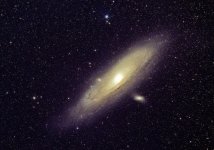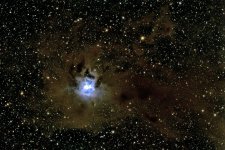Space Thread
- Thread starter B00Mer
- Start date
You are using an out of date browser. It may not display this or other websites correctly.
You should upgrade or use an alternative browser.
You should upgrade or use an alternative browser.
No, astro-modified DSLR, direct focus attached with a T-ring adapter on a tracking mount. Each photo is over 3 hours exposure time.Nice! Camera eye piece I assume?
NASA on Monday released two new images of Jupiter from the James Webb Space Telescope that showcase the planet's features in detail.
The images were captured by the telescope's near-infrared camera, which uses infrared radiation to detect objects in space.

New Webb images of Jupiter highlight the planet's features, including its turbulent Great Red Spot. Here, it is depicted in space with enhanced color, in a composite image released by NASA. The planet’s Great Red Spot appears white and is striated with swirling horizontal stripes of neon turquoise, periwinkle, light pink, and cream.
NASA/Instagram
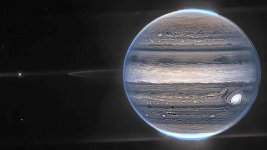
The second image shows a wider view of Jupiter, including its rings, which are a million times fainter than the planet, according to the space agency.
Also seen are two of Jupiter's moons -- Adrastea and Amalthea -- which are located to the far left of the rings.
Although the rest of the image shows the blackness of space, there are fuzzy spots in the lower portion, which are actually faint galaxies glowing in the distance.
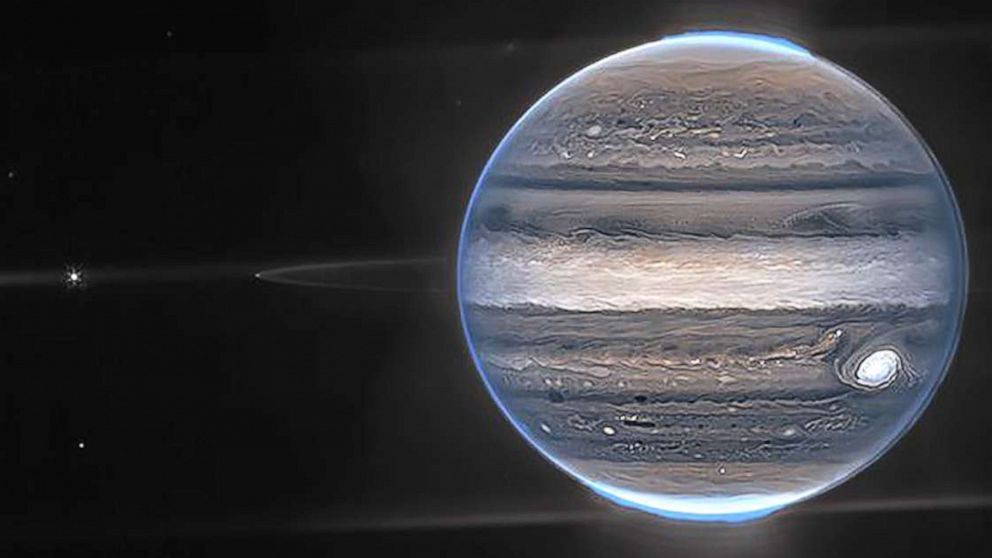
 abcnews.go.com
abcnews.go.com
The images were captured by the telescope's near-infrared camera, which uses infrared radiation to detect objects in space.

New Webb images of Jupiter highlight the planet's features, including its turbulent Great Red Spot. Here, it is depicted in space with enhanced color, in a composite image released by NASA. The planet’s Great Red Spot appears white and is striated with swirling horizontal stripes of neon turquoise, periwinkle, light pink, and cream.
NASA/Instagram

The second image shows a wider view of Jupiter, including its rings, which are a million times fainter than the planet, according to the space agency.
Also seen are two of Jupiter's moons -- Adrastea and Amalthea -- which are located to the far left of the rings.
Although the rest of the image shows the blackness of space, there are fuzzy spots in the lower portion, which are actually faint galaxies glowing in the distance.

NASA releases stunning new images of Jupiter from Webb telescope
NASA released two new images of Jupiter Monday taken by the James Webb Space Telescope, showing the planet's features in great detail.
NASA posts what a black hole sounds like. One review: 'Cosmic horror.'
Author of the article:Washington Post
Washington Post
Annabelle Timsit, The Washington Post
Publishing date:Aug 23, 2022 • 12 hours ago • 5 minute read • Join the conversation
What does a black hole sound like? Both “creepy” and “ethereally beautiful,” according to people who’ve listened to an audio clip posted on Twitter by NASA.
The U.S. space agency tweeted what it called a remixed sonification of the black hole at the center of a galaxy cluster known as Perseus, which lies about 240 million light-years away from Earth. The sound waves identified there nearly two decades ago were “extracted and made audible” for the first time this year, according to NASA.
The 34-second clip set social media ablaze, with many people gobsmacked that anything, let alone what sounds like an eerie, guttural moan, could escape a black hole.
But the idea that there is no sound in space is actually a “popular misconception,” the agency said. While most of space is a vacuum, with no medium for sound waves to travel through, a galaxy cluster “has copious amounts of gas that envelop the hundreds or even thousands of galaxies within it, providing a medium for the sound waves to travel,” it explained.
The clip, which NASA described as a “Black Hole Remix,” was first released in early May to coincide with NASA’s Black Hole Week – but a tweet Sunday by the NASA exoplanets team really look off, with the clip being viewed more than 13 million times.
The sound waves were discovered in 2003, when, after 53 hours of observation, researchers with NASA’s Chandra X-Ray Observatory “discovered that pressure waves sent out by the black hole caused ripples in the cluster’s hot gas that could be translated into a note.”
But humans couldn’t hear that note because its frequency was too low – the equivalent to a B-flat, some 57 octaves below the middle C note of a piano, according to NASA. So astronomers at Chandra remixed the sound and increased its frequency by 57 and 58 octaves. “Another way to put this is that they are being heard 144 quadrillion and 288 quadrillion times higher than their original frequency,” NASA said.
Kimberly Arcand, the principal investigator of the sonification project, said that when she first heard the sound in late 2021 – which she described as “a beautiful Hans Zimmer score with the moody level set at really high” – she jumped up in excitement.
“It was such a wonderful representation of what existed in my mind,” the visualization scientist and emerging technology lead at Chandra told The Post. But it was also a “tipping point” for the sonification program as a whole in that it “really sparked people’s imagination,” she said.
It also points to future areas of research. “The idea that there are these supermassive black holes sprinkled throughout the universe that are . . . belching out incredible songs is a very tantalizing thing,” Arcand added.
Experts have cautioned that the sound in NASA’s remix isn’t exactly what you’d hear if you were somehow standing beside a black hole. Human ears wouldn’t “be sensitive enough to be able to pick up those sound waves,” Michael Smith, professor of astronomy at the University of Kent in England, told The Washington Post. “But they are there, they’re the right sort of frequency, and if we amplified it . . . we would then be able to hear it,” Smith said. He likened it to a radio – “you turn up the sound, the volume is higher, then you can hear it.”
Arcand said the idea took shape during the coronavirus pandemic. She had been working on turning X-ray light captured by Chandra’s orbiting telescope into images, including creating 3D models that could be printed to help people with low or no vision access that data. When the pandemic hit, that program became difficult to maintain remotely.
So, with other colleagues, she decided to try something new: sonification, or the process of translating astronomical data into sound. The team included experts who are blind and inspired Arcand “to think differently” about the value of translating complex data sets into sound.
Looking at the 2003 data on the Perseus galaxy cluster, she and colleagues worked to determine the properties of the pressure waves and deduce the sound they would produce, and then upped their frequency.
The decision to release the “re-sonification” of the nearly two-decades-old data is part of the agency’s efforts to use social media to communicate complex scientific discoveries in plain English to its millions of followers.
Through a partnership with Twitter, NASA discovered that “while its fans enjoyed stunning photos of space and behind-the-scenes looks into missions, there was a group of people who wanted to know what space sounded like, too,” the company wrote in a news release.
Some experts said the clip was confusing because it gave the impression that the sound “was somehow what you would hear if you were there,” Chris Lintott, a professor of astrophysics at the University of Oxford, wrote Tuesday on Twitter – as if you had a recording device directly translating the sound from the galaxy cluster to Earth.
“Sonification of data is fun, and can be useful – especially for those who may not be able to see images. But it’s sometimes used to make things seem more ‘profound’ than they are, like here,” Lintott added.
But Smith, the University of Kent professor, said “it’s perfectly sensible to say that there are sound waves [in the galaxy cluster], and if we were there, we could hear them if we had sensitive enough ears.”
Still, he acknowledged, “these galaxy clusters are so far away, they have to make a lot of assumptions to turn it into what we might hear if we were there.”
Arcand said she understood the criticism from some corners that sonification risks oversimplifying a complex process – particularly because the mix of pressure, heat and gas enabling the sound waves within the Perseus galaxy cluster is specific to that environment. But the value of sonification, she said, is that it made her “question things in different ways.”
“It’s a superb representation of the science, in my opinion, and a rather haunting sound!” Carole Mundell, head of astrophysics at the University of Bath in England, told The Post via email.
The project, and NASA’s tweets about it, appear to have accomplished the space agency’s mission of sharing its science and research with the wider public in a conversational way – though not everyone was a fan of the remixed sounds of the black hole.
Online, people appeared both thrilled and terrified by it, making colorful comparisons to films from “Lord of the Rings” to “Silent Hill.”
Others had fun with the audio clip, overlaying an image of an intergalactic puppy onto it or remixing it with a re-created sound thought to be closest to the voice of a mummy.
“I can confirm that the black hole noise Nasa released is the sound of hell,” one dark-humored Twitter user wrote. Another said: “New genre just dropped: Cosmic Horror.”
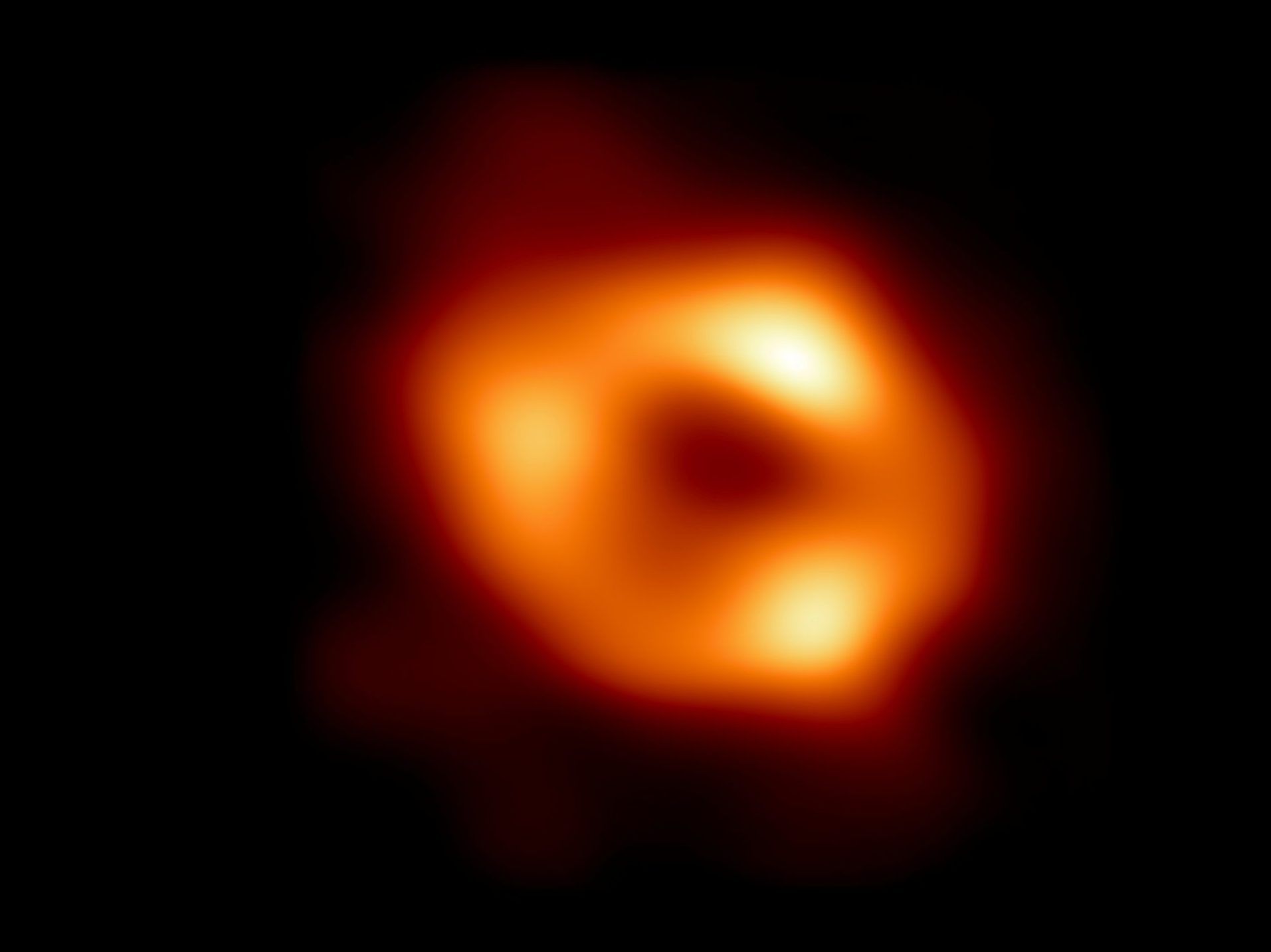
 torontosun.com
torontosun.com
Author of the article:Washington Post
Washington Post
Annabelle Timsit, The Washington Post
Publishing date:Aug 23, 2022 • 12 hours ago • 5 minute read • Join the conversation
What does a black hole sound like? Both “creepy” and “ethereally beautiful,” according to people who’ve listened to an audio clip posted on Twitter by NASA.
The U.S. space agency tweeted what it called a remixed sonification of the black hole at the center of a galaxy cluster known as Perseus, which lies about 240 million light-years away from Earth. The sound waves identified there nearly two decades ago were “extracted and made audible” for the first time this year, according to NASA.
The 34-second clip set social media ablaze, with many people gobsmacked that anything, let alone what sounds like an eerie, guttural moan, could escape a black hole.
But the idea that there is no sound in space is actually a “popular misconception,” the agency said. While most of space is a vacuum, with no medium for sound waves to travel through, a galaxy cluster “has copious amounts of gas that envelop the hundreds or even thousands of galaxies within it, providing a medium for the sound waves to travel,” it explained.
The clip, which NASA described as a “Black Hole Remix,” was first released in early May to coincide with NASA’s Black Hole Week – but a tweet Sunday by the NASA exoplanets team really look off, with the clip being viewed more than 13 million times.
The sound waves were discovered in 2003, when, after 53 hours of observation, researchers with NASA’s Chandra X-Ray Observatory “discovered that pressure waves sent out by the black hole caused ripples in the cluster’s hot gas that could be translated into a note.”
But humans couldn’t hear that note because its frequency was too low – the equivalent to a B-flat, some 57 octaves below the middle C note of a piano, according to NASA. So astronomers at Chandra remixed the sound and increased its frequency by 57 and 58 octaves. “Another way to put this is that they are being heard 144 quadrillion and 288 quadrillion times higher than their original frequency,” NASA said.
Kimberly Arcand, the principal investigator of the sonification project, said that when she first heard the sound in late 2021 – which she described as “a beautiful Hans Zimmer score with the moody level set at really high” – she jumped up in excitement.
“It was such a wonderful representation of what existed in my mind,” the visualization scientist and emerging technology lead at Chandra told The Post. But it was also a “tipping point” for the sonification program as a whole in that it “really sparked people’s imagination,” she said.
It also points to future areas of research. “The idea that there are these supermassive black holes sprinkled throughout the universe that are . . . belching out incredible songs is a very tantalizing thing,” Arcand added.
Experts have cautioned that the sound in NASA’s remix isn’t exactly what you’d hear if you were somehow standing beside a black hole. Human ears wouldn’t “be sensitive enough to be able to pick up those sound waves,” Michael Smith, professor of astronomy at the University of Kent in England, told The Washington Post. “But they are there, they’re the right sort of frequency, and if we amplified it . . . we would then be able to hear it,” Smith said. He likened it to a radio – “you turn up the sound, the volume is higher, then you can hear it.”
Arcand said the idea took shape during the coronavirus pandemic. She had been working on turning X-ray light captured by Chandra’s orbiting telescope into images, including creating 3D models that could be printed to help people with low or no vision access that data. When the pandemic hit, that program became difficult to maintain remotely.
So, with other colleagues, she decided to try something new: sonification, or the process of translating astronomical data into sound. The team included experts who are blind and inspired Arcand “to think differently” about the value of translating complex data sets into sound.
Looking at the 2003 data on the Perseus galaxy cluster, she and colleagues worked to determine the properties of the pressure waves and deduce the sound they would produce, and then upped their frequency.
The decision to release the “re-sonification” of the nearly two-decades-old data is part of the agency’s efforts to use social media to communicate complex scientific discoveries in plain English to its millions of followers.
Through a partnership with Twitter, NASA discovered that “while its fans enjoyed stunning photos of space and behind-the-scenes looks into missions, there was a group of people who wanted to know what space sounded like, too,” the company wrote in a news release.
Some experts said the clip was confusing because it gave the impression that the sound “was somehow what you would hear if you were there,” Chris Lintott, a professor of astrophysics at the University of Oxford, wrote Tuesday on Twitter – as if you had a recording device directly translating the sound from the galaxy cluster to Earth.
“Sonification of data is fun, and can be useful – especially for those who may not be able to see images. But it’s sometimes used to make things seem more ‘profound’ than they are, like here,” Lintott added.
But Smith, the University of Kent professor, said “it’s perfectly sensible to say that there are sound waves [in the galaxy cluster], and if we were there, we could hear them if we had sensitive enough ears.”
Still, he acknowledged, “these galaxy clusters are so far away, they have to make a lot of assumptions to turn it into what we might hear if we were there.”
Arcand said she understood the criticism from some corners that sonification risks oversimplifying a complex process – particularly because the mix of pressure, heat and gas enabling the sound waves within the Perseus galaxy cluster is specific to that environment. But the value of sonification, she said, is that it made her “question things in different ways.”
“It’s a superb representation of the science, in my opinion, and a rather haunting sound!” Carole Mundell, head of astrophysics at the University of Bath in England, told The Post via email.
The project, and NASA’s tweets about it, appear to have accomplished the space agency’s mission of sharing its science and research with the wider public in a conversational way – though not everyone was a fan of the remixed sounds of the black hole.
Online, people appeared both thrilled and terrified by it, making colorful comparisons to films from “Lord of the Rings” to “Silent Hill.”
Others had fun with the audio clip, overlaying an image of an intergalactic puppy onto it or remixing it with a re-created sound thought to be closest to the voice of a mummy.
“I can confirm that the black hole noise Nasa released is the sound of hell,” one dark-humored Twitter user wrote. Another said: “New genre just dropped: Cosmic Horror.”

NASA posts what a black hole sounds like. One review: 'Cosmic horror.'
What does a black hole sound like? Both “creepy” and “ethereally beautiful,” according to people who’ve listened to an audio clip posted on Twitter by NASA.
Artemis space mission to moon 'a stepping-stone' to Mars and beyond
Author of the article:Canadian Press
Canadian Press
Bob Weber
Publishing date:Aug 28, 2022 • 16 hours ago • 3 minute read • Join the conversation
The Artemis 1 rocket stands ready for launch on Pad 39B at the Kennedy Space Center, Thursday, Aug. 25, 2022, in Cape Canaveral, Fla.
The Artemis 1 rocket stands ready for launch on Pad 39B at the Kennedy Space Center, Thursday, Aug. 25, 2022, in Cape Canaveral, Fla. PHOTO BY JOHN RAOUX /THE ASSOCIATED PRESS
The last time humans went to the moon, it was a destination.
But when NASA’s Artemis 1 mission launches Monday, the moon will be more of a way station.
“It’s really to learn how we can go further,” said Isabelle Tremblay of the Canadian Space Agency, which is playing a big role in the Artemis missions. “It’s really to learn how we can go to Mars.”
Artemis 1 is the first in a series of flights intended to result in a base orbiting the moon, from which crews can then venture into the solar system. The mission is to deposit 10 scientific satellites in lunar orbits, but the main thrust is to test NASA’s new launch system and Orion spacecraft for Artemis 2.
That’s when things get really interesting. Artemis 2, planned for spring 2024, would be the first crewed mission to the moon since the last Apollo mission a half-century ago.
“There will be for sure a Canadian among the crew,” Tremblay said.
Artemis 2 will orbit the moon and astronauts in Artemis 3 will land on it. But the Artemis missions aim to go beyond Earth’s satellite to build the Lunar Gateway. The small space station orbiting the moon can be used as a takeoff point for future missions to Mars and beyond.
That’s where Canada’s main contribution to the Artemis program will shine. The Gateway will feature a third version of the famed robotic Canadarm.
Canadarm 3 will actually offer two hands, meaning one hand will be able to repair the other. It will maintain, repair and inspect the Gateway, snag visiting vehicles as they sail by, adjust Gateway’s working modules, help astronauts during spacewalks and assist with scientific measurements. It will be operated both remotely from Earth and autonomously, working on its own.
Contributions such as the Canadarm are why Canadian scientists and astronauts play such a prominent role in space exploration, Tremblay said.
“We always say we punch above our weight.”
In addition to the Canadarm, Canadian science and technology is behind the machinery that aims NASA’s new James Webb space telescope, currently beaming amazing images back to Earth of some of the oldest galaxies in existence.
Canada’s contribution to the US$10-billion James Webb was $178 million for design and build and $16.5 million in science support, up to 2021 — and it gets about five per cent of the telescope’s viewing time.
Canadian science is also contributing in other ways.
Scientists and private companies are involved in a NASA challenge to create appetizing, healthy food that can be grown in space. Others are leading in space medicine.
A University of British Columbia experiment on Artemis 1 is to examine the effect deep space radiation can have on yeast and algae cells, which could be grown for both nutrition and fuel.
Canadarm 3 is projected to cost a total of $1.9 billion over 24 years.
It’s a good investment, said Tremblay.
There are technical and scientific spinoffs for those left on Earth. Space exploration can help with challenges such as food security and health care, Tremblay said.
Commercial opportunities may also follow.
“The moon has become a strategic objective,” said Tremblay. “There may be resources we can use to go further, but there may be resources that are useful for us.”
Artemis 1 is to be in space for up to 42 days, orbit the moon and travel more than two million kilometres.
But that will be just the start of Artemis’ challenge to the big black beyond.
“The moon is a stepping-stone to Mars,” Tremblay said. “It’s at the moon we can learn to go further.”
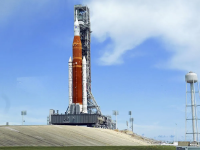
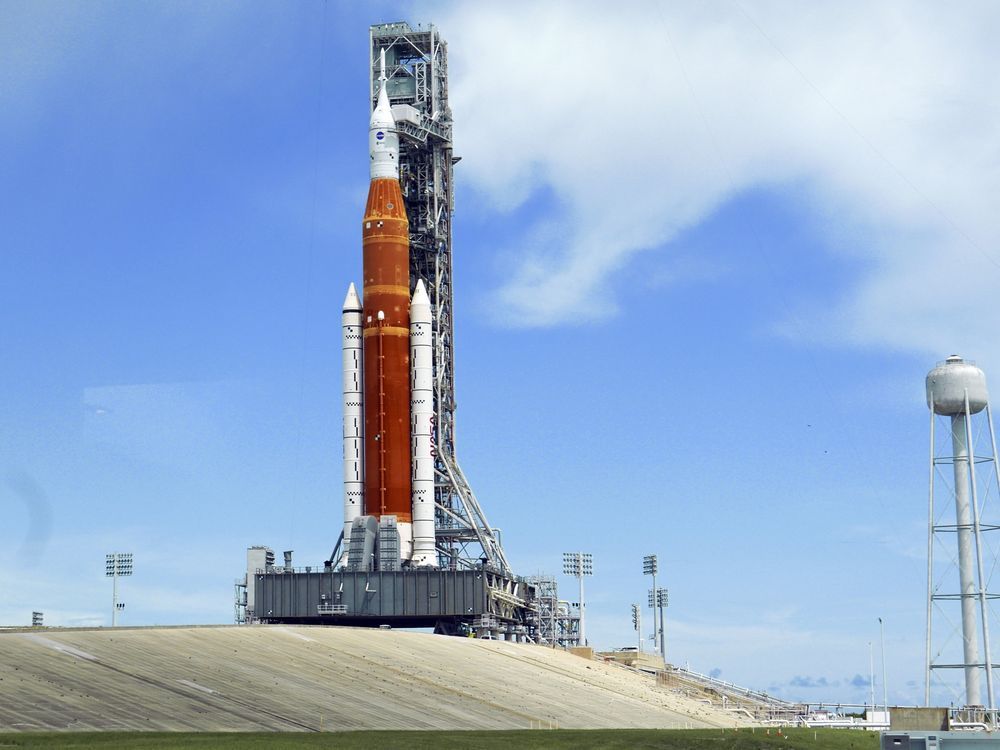
 torontosun.com
torontosun.com
Author of the article:Canadian Press
Canadian Press
Bob Weber
Publishing date:Aug 28, 2022 • 16 hours ago • 3 minute read • Join the conversation
The Artemis 1 rocket stands ready for launch on Pad 39B at the Kennedy Space Center, Thursday, Aug. 25, 2022, in Cape Canaveral, Fla.
The Artemis 1 rocket stands ready for launch on Pad 39B at the Kennedy Space Center, Thursday, Aug. 25, 2022, in Cape Canaveral, Fla. PHOTO BY JOHN RAOUX /THE ASSOCIATED PRESS
The last time humans went to the moon, it was a destination.
But when NASA’s Artemis 1 mission launches Monday, the moon will be more of a way station.
“It’s really to learn how we can go further,” said Isabelle Tremblay of the Canadian Space Agency, which is playing a big role in the Artemis missions. “It’s really to learn how we can go to Mars.”
Artemis 1 is the first in a series of flights intended to result in a base orbiting the moon, from which crews can then venture into the solar system. The mission is to deposit 10 scientific satellites in lunar orbits, but the main thrust is to test NASA’s new launch system and Orion spacecraft for Artemis 2.
That’s when things get really interesting. Artemis 2, planned for spring 2024, would be the first crewed mission to the moon since the last Apollo mission a half-century ago.
“There will be for sure a Canadian among the crew,” Tremblay said.
Artemis 2 will orbit the moon and astronauts in Artemis 3 will land on it. But the Artemis missions aim to go beyond Earth’s satellite to build the Lunar Gateway. The small space station orbiting the moon can be used as a takeoff point for future missions to Mars and beyond.
That’s where Canada’s main contribution to the Artemis program will shine. The Gateway will feature a third version of the famed robotic Canadarm.
Canadarm 3 will actually offer two hands, meaning one hand will be able to repair the other. It will maintain, repair and inspect the Gateway, snag visiting vehicles as they sail by, adjust Gateway’s working modules, help astronauts during spacewalks and assist with scientific measurements. It will be operated both remotely from Earth and autonomously, working on its own.
Contributions such as the Canadarm are why Canadian scientists and astronauts play such a prominent role in space exploration, Tremblay said.
“We always say we punch above our weight.”
In addition to the Canadarm, Canadian science and technology is behind the machinery that aims NASA’s new James Webb space telescope, currently beaming amazing images back to Earth of some of the oldest galaxies in existence.
Canada’s contribution to the US$10-billion James Webb was $178 million for design and build and $16.5 million in science support, up to 2021 — and it gets about five per cent of the telescope’s viewing time.
Canadian science is also contributing in other ways.
Scientists and private companies are involved in a NASA challenge to create appetizing, healthy food that can be grown in space. Others are leading in space medicine.
A University of British Columbia experiment on Artemis 1 is to examine the effect deep space radiation can have on yeast and algae cells, which could be grown for both nutrition and fuel.
Canadarm 3 is projected to cost a total of $1.9 billion over 24 years.
It’s a good investment, said Tremblay.
There are technical and scientific spinoffs for those left on Earth. Space exploration can help with challenges such as food security and health care, Tremblay said.
Commercial opportunities may also follow.
“The moon has become a strategic objective,” said Tremblay. “There may be resources we can use to go further, but there may be resources that are useful for us.”
Artemis 1 is to be in space for up to 42 days, orbit the moon and travel more than two million kilometres.
But that will be just the start of Artemis’ challenge to the big black beyond.
“The moon is a stepping-stone to Mars,” Tremblay said. “It’s at the moon we can learn to go further.”


Artemis space mission to moon 'a stepping-stone' to Mars and beyond
The last time humans went to the moon, it was a destination.
Engine problem leads NASA to scrub launch of new moon rocket
Author of the article:Associated Press
Associated Press
Marcia Dunn
Publishing date:Aug 29, 2022 • 12 hours ago • 3 minute read • Join the conversation
CAPE CANAVERAL, Fla. (AP) — NASA called off the launch of its mighty new moon rocket on its debut flight with three test dummies aboard Monday after a last-minute cascade of problems culminating in unexplained trouble related to an engine.
The next launch attempt will not take place until Friday at the earliest and could be delayed until mid-September or later.
The mission will be the first flight in NASA’s Artemis project, a quest to put astronauts back on the moon for the first time since the Apollo program ended 50 years ago.
As precious minutes ticked away Monday morning, NASA repeatedly stopped and started the fueling of the Space Launch System rocket because of a leak of highly explosive hydrogen, eventually succeeding in reducing the seepage to acceptable levels. The leak happened in the same place that saw seepage during a dress rehearsal in the spring.
The fueling already was running nearly an hour late because of thunderstorms off Florida’s Kennedy Space Center.
Then, NASA ran into new trouble when it was unable to properly chill one of the rocket’s four main engines, officials said. Engineers continued working to pinpoint the source of the problem after the launch postponement was announced.
“This is a very complicated machine, a very complicated system, and all those things have to work, and you don’t want to light the candle until it’s ready to go,” said NASA Administrator Bill Nelson.
Referring to launch delays, he said: “It’s just part of the space business and it’s part of, particularly, a test flight.”
The rocket was set to lift off on a flight to propel a crew capsule into orbit around the moon. The six-week mission was scheduled to end with the capsule returning to Earth in a splashdown in the Pacific in October.
The 322-foot (98-metre) spaceship is the most powerful rocket ever built by NASA, out-muscling even the Saturn V that took the Apollo astronauts to the moon.
The dummies inside the Orion capsule were fitted with sensors to measure vibration, cosmic radiation and other conditions during the shakedown flight, meant to stress-test the spacecraft and push it to its limits in ways that would never be attempted if humans were aboard.
Asked about the possibility of another launch attempt on Friday, mission manager Mike Sarafin said, “We really need time to look at all the information, all the data.”
Even though no one was on board, thousands of people jammed the coast to see the rocket soar. Vice President Kamala Harris and Apollo 10 astronaut Tom Stafford were among the VIPs who arrived.
Assuming the shakedown flight goes well, astronauts will climb aboard for the second Artemis mission and fly around the moon and back as soon as 2024. A two-person lunar landing could follow by the end of 2025.
The problems seen Monday were reminiscent of NASA’s space shuttle era, when hydrogen fuel leaks disrupted countdowns and delayed a string of launches back in 1990.
Later in the morning, NASA also officials spotted what they feared was a crack or some other defect on the core stage — the big orange fuel tank with four main engines on it — but they later said it appeared to be just a buildup of frost in a crevice of the insulating foam.
Launch director Charlie Blackwell-Thompson and her team also had to deal with a communication problem involving the Orion capsule.
Engineers scrambled to understand an 11-minute delay in the communication lines between launch control and Orion that cropped up late Sunday. Though the problem had cleared by Monday morning, NASA needed to know why it happened before committing to a launch.
Regardless of all the technical snags, thunderstorms ultimately would have prevented a liftoff. Dark clouds gathered over the launch site as soon as Blackwell-Thompson halted the countdown, with thunder echoing across the coast.
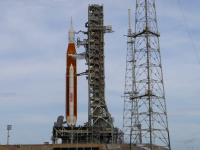
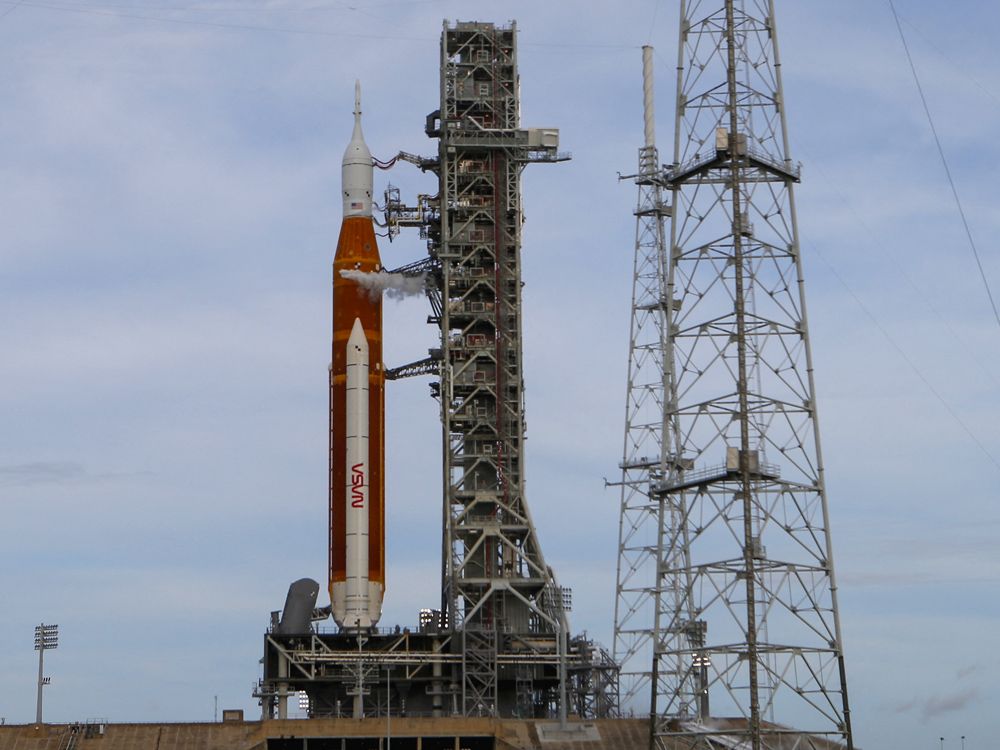
 torontosun.com
torontosun.com
Author of the article:Associated Press
Associated Press
Marcia Dunn
Publishing date:Aug 29, 2022 • 12 hours ago • 3 minute read • Join the conversation
CAPE CANAVERAL, Fla. (AP) — NASA called off the launch of its mighty new moon rocket on its debut flight with three test dummies aboard Monday after a last-minute cascade of problems culminating in unexplained trouble related to an engine.
The next launch attempt will not take place until Friday at the earliest and could be delayed until mid-September or later.
The mission will be the first flight in NASA’s Artemis project, a quest to put astronauts back on the moon for the first time since the Apollo program ended 50 years ago.
As precious minutes ticked away Monday morning, NASA repeatedly stopped and started the fueling of the Space Launch System rocket because of a leak of highly explosive hydrogen, eventually succeeding in reducing the seepage to acceptable levels. The leak happened in the same place that saw seepage during a dress rehearsal in the spring.
The fueling already was running nearly an hour late because of thunderstorms off Florida’s Kennedy Space Center.
Then, NASA ran into new trouble when it was unable to properly chill one of the rocket’s four main engines, officials said. Engineers continued working to pinpoint the source of the problem after the launch postponement was announced.
“This is a very complicated machine, a very complicated system, and all those things have to work, and you don’t want to light the candle until it’s ready to go,” said NASA Administrator Bill Nelson.
Referring to launch delays, he said: “It’s just part of the space business and it’s part of, particularly, a test flight.”
The rocket was set to lift off on a flight to propel a crew capsule into orbit around the moon. The six-week mission was scheduled to end with the capsule returning to Earth in a splashdown in the Pacific in October.
The 322-foot (98-metre) spaceship is the most powerful rocket ever built by NASA, out-muscling even the Saturn V that took the Apollo astronauts to the moon.
The dummies inside the Orion capsule were fitted with sensors to measure vibration, cosmic radiation and other conditions during the shakedown flight, meant to stress-test the spacecraft and push it to its limits in ways that would never be attempted if humans were aboard.
Asked about the possibility of another launch attempt on Friday, mission manager Mike Sarafin said, “We really need time to look at all the information, all the data.”
Even though no one was on board, thousands of people jammed the coast to see the rocket soar. Vice President Kamala Harris and Apollo 10 astronaut Tom Stafford were among the VIPs who arrived.
Assuming the shakedown flight goes well, astronauts will climb aboard for the second Artemis mission and fly around the moon and back as soon as 2024. A two-person lunar landing could follow by the end of 2025.
The problems seen Monday were reminiscent of NASA’s space shuttle era, when hydrogen fuel leaks disrupted countdowns and delayed a string of launches back in 1990.
Later in the morning, NASA also officials spotted what they feared was a crack or some other defect on the core stage — the big orange fuel tank with four main engines on it — but they later said it appeared to be just a buildup of frost in a crevice of the insulating foam.
Launch director Charlie Blackwell-Thompson and her team also had to deal with a communication problem involving the Orion capsule.
Engineers scrambled to understand an 11-minute delay in the communication lines between launch control and Orion that cropped up late Sunday. Though the problem had cleared by Monday morning, NASA needed to know why it happened before committing to a launch.
Regardless of all the technical snags, thunderstorms ultimately would have prevented a liftoff. Dark clouds gathered over the launch site as soon as Blackwell-Thompson halted the countdown, with thunder echoing across the coast.


Engine problem leads NASA to scrub launch of new moon rocket
A fuel leak and then an engine problem during final liftoff preparations led NASA to scrub the launch of its mighty new moon rocket Monday.
NASA to make second attempt at debut moon rocket launch on Saturday
Author of the article:Reuters
Reuters
Publishing date:Aug 30, 2022 • 12 hours ago • 1 minute read • Join the conversation
NASA's next-generation moon rocket, the Space Launch System, with the Orion crew capsule perched on top, stands on launch complex 39B one day after an engine-cooling problem forced NASA to delay the debut test launch at Cape Canaveral, Fla., Tuesday, Aug. 30, 2022.
NASA's next-generation moon rocket, the Space Launch System, with the Orion crew capsule perched on top, stands on launch complex 39B one day after an engine-cooling problem forced NASA to delay the debut test launch at Cape Canaveral, Fla., Tuesday, Aug. 30, 2022. PHOTO BY STEVE NESIUS /REUTERS
WASHINGTON — NASA aims to make a second attempt on Saturday, Sept. 3 to launch its new Space Launch System (SLS) moon rocket, five days after a pair of technical issues foiled an attempt on Monday, agency officials said on Tuesday.
Plans call for the 32-story-tall SLS rocket to blast off from the Kennedy Space Center in Cape Canaveral, Florida, sending its Orion capsule on an uncrewed, six-week test flight around the moon and back to Earth.
The long-awaited launch would kick off the U.S. space agency’s moon-to-Mars Artemis program, successor to the Apollo moon project of the 1960s and 1970s.
The first voyage of the SLS-Orion, a mission dubbed Artemis I, aims to put the 5.75-million-pound vehicle through its paces in a rigorous demonstration flight pushing its design limits, before NASA deems it reliable enough to carry astronauts.
NASA’s initial Artemis I launch attempt on Monday ended with a cooling problem with one the rocket’s main-stage engines, forcing a halt to the countdown and a postponement.
At a news briefing on Tuesday, NASA officials said they hoped to have those issues resolved in time for a launch retry on Saturday.

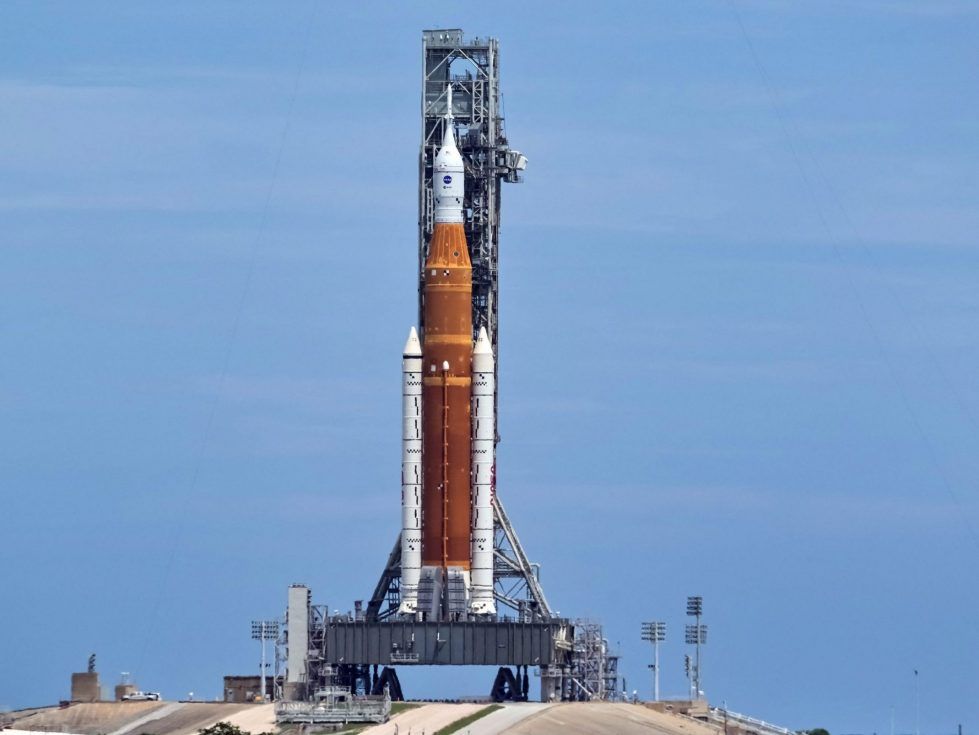
 torontosun.com
torontosun.com
Author of the article:Reuters
Reuters
Publishing date:Aug 30, 2022 • 12 hours ago • 1 minute read • Join the conversation
NASA's next-generation moon rocket, the Space Launch System, with the Orion crew capsule perched on top, stands on launch complex 39B one day after an engine-cooling problem forced NASA to delay the debut test launch at Cape Canaveral, Fla., Tuesday, Aug. 30, 2022.
NASA's next-generation moon rocket, the Space Launch System, with the Orion crew capsule perched on top, stands on launch complex 39B one day after an engine-cooling problem forced NASA to delay the debut test launch at Cape Canaveral, Fla., Tuesday, Aug. 30, 2022. PHOTO BY STEVE NESIUS /REUTERS
WASHINGTON — NASA aims to make a second attempt on Saturday, Sept. 3 to launch its new Space Launch System (SLS) moon rocket, five days after a pair of technical issues foiled an attempt on Monday, agency officials said on Tuesday.
Plans call for the 32-story-tall SLS rocket to blast off from the Kennedy Space Center in Cape Canaveral, Florida, sending its Orion capsule on an uncrewed, six-week test flight around the moon and back to Earth.
The long-awaited launch would kick off the U.S. space agency’s moon-to-Mars Artemis program, successor to the Apollo moon project of the 1960s and 1970s.
The first voyage of the SLS-Orion, a mission dubbed Artemis I, aims to put the 5.75-million-pound vehicle through its paces in a rigorous demonstration flight pushing its design limits, before NASA deems it reliable enough to carry astronauts.
NASA’s initial Artemis I launch attempt on Monday ended with a cooling problem with one the rocket’s main-stage engines, forcing a halt to the countdown and a postponement.
At a news briefing on Tuesday, NASA officials said they hoped to have those issues resolved in time for a launch retry on Saturday.


NASA to make second attempt at debut moon rocket launch on Saturday
NASA aims to make a second attempt on Saturday, Sept. 3 to launch its new Space Launch System moon rocket.
NASA calls off retry of Artemis moon rocket launch, citing fuel leak
Author of the article:Reuters
Reuters
Joey Roulette and Steve Gorman
Publishing date:Sep 03, 2022 • 9 hours ago • 4 minute read • Join the conversation
In this NASA handout, NASA's Space Launch System (SLS) rocket with the Orion spacecraft aboard is seen atop the mobile launcher at Launch Pad 39B, as the Artemis I launch teams load more than 700,000 gallons of cryogenic propellants including liquid hydrogen and liquid oxygen as the launch countdown progresses at Kennedy Space Center on Sept. 3, 2022 in Cape Canaveral, Fla.
In this NASA handout, NASA's Space Launch System (SLS) rocket with the Orion spacecraft aboard is seen atop the mobile launcher at Launch Pad 39B, as the Artemis I launch teams load more than 700,000 gallons of cryogenic propellants including liquid hydrogen and liquid oxygen as the launch countdown progresses at Kennedy Space Center on Sept. 3, 2022 in Cape Canaveral, Fla. PHOTO BY NASA /Photographer: NASA/Getty Images
CAPE CANAVERAL — For the second time in a week, NASA on Saturday aborted an attempt to launch its giant, next-generation rocketship, citing a stubborn fuel leak that the space agency said could delay the debut mission of its moon-to-Mars Artemis program by at least several weeks.
Preflight operations were called off for the day about three hours before the 2:17 p.m. EDT liftoff time targeted for the 32-story-tall Space Launch System (SLS) rocket and its Orion capsule from Cape Canaveral, Florida.
The uncrewed test flight, aimed at launching the capsule out to the moon and back, was to have marked the inaugural voyage of both the SLS and Orion a half century after the last lunar mission of Apollo, forerunner of the Artemis program.
The countdown was scrubbed after Kennedy Space Center technicians made three failed attempts to fix a “large” leak of supercooled liquid hydrogen propellant being pumped into the rocket’s core-stage fuel tanks, agency officials said.
NASA’s next-generation moon rocket, the Space Launch System (SLS), with the Orion crew capsule, is seen on launch complex 39B after its launch on the Artemis 1 mission was delayed, at Cape Canaveral, Fla., Sept. 3, 2022.
NASA’s next-generation moon rocket, the Space Launch System (SLS), with the Orion crew capsule, is seen on launch complex 39B after its launch on the Artemis 1 mission was delayed, at Cape Canaveral, Fla., Sept. 3, 2022. PHOTO BY THOM BAUR /REUTERS
The initial launch try on Monday was likewise foiled by technical problems, including a different leaky fuel line, a faulty temperature sensor and cracks found in insulation foam.
Mission managers proceeded with a second launch attempt on Saturday once the earlier issues had been resolved to their satisfaction. And NASA had reserved another backup launch time, for either Monday or Tuesday, in case a third try was needed.
But after a review of data from the latest difficulties, NASA concluded the new hydrogen leak was too tricky and time-consuming to finish troubleshooting and fix on the launch pad before the current launch period allotted to the mission expires on Tuesday.
The delay means the earliest opportunity to try again would come during the next launch period that runs Sept. 19-30, or during a subsequent October window, an associate NASA administrator, Jim Free, told reporters at a late-afternoon briefing.
He said the postponement also would involve rolling the spacecraft back into its assembly building, under Cape Canaveral “range” rules limiting how long a rocket may remain at its launch tower before undergoing a new round of safety checks indoors.
Mike Sarafin, NASA’s Artemis mission manager, said efforts to resolve the latest technical snag would entail “several weeks of work.”
NASA chief Bill Nelson said earlier in the day that a rollback would postpone the next launch attempt at least until mid-October, in part to avoid a scheduling conflict with the next International Space Station crew due for launch early that month.
Launch-day delays and malfunctions are not uncommon in the space business, especially for new rockets such as NASA’s Space Launch System, a complex vehicle with a set of pre-liftoff procedures that have yet to be fully tested and rehearsed by engineers without a hitch.
On average, the odds of scrubbing a launch on any given day for any reason, including foul weather, are about one-in-three.
“We’re not going to launch until it’s right, and that is standard operating procedure, and will continue to be,” Nelson said at the briefing.
The last-minute setbacks on the launchpad came at the tail end of a development program more than a decade in the making, with years of delays and billions of dollars in cost overruns under NASA’s respective SLS and Orion contracts with Boeing Co and Lockheed Martin Corp.
MOON TO MARS
Apart from its technical challenges, Artemis I signals a major turning point for NASA’s post-Apollo human spaceflight program, after decades focused on low-Earth orbit with space shuttles and the International Space Station.
Named for the goddess who was Apollo’s twin sister in ancient Greek mythology, Artemis aims to return astronauts to the moon’s surface as early as 2025, though many experts believe that time frame will likely slip.
Twelve astronauts walked on the moon during six Apollo missions from 1969 to 1972, the only spaceflights yet to place humans on the lunar surface. But Apollo, born of the U.S.-Soviet space race during the Cold War, was less science-driven than Artemis.
The new moon program has enlisted commercial partners such as SpaceX and the space agencies of Europe, Canada and Japan to eventually establish a long-term lunar base of operations as a stepping stone to even more ambitious human voyages to Mars.
Getting the SLS-Orion spacecraft launched is a key first step. Its first voyage is intended to put the 5.75-million-pound vehicle through its paces in a rigorous test flight pushing its design limits and aiming to prove the spacecraft suitable to fly astronauts.
If the mission succeeds, a crewed Artemis II flight around the moon and back could come as early as 2024, to be followed within a few more years with the program’s first lunar landing of astronauts, one of them a woman, with Artemis III.
Billed as the most powerful, complex rocket in the world, the SLS represents the biggest new vertical launch system NASA has built since the Saturn V of the Apollo era.
Although no humans will be aboard, Orion will carry a simulated crew of three – one male and two female mannequins – fitted with sensors to measure radiation levels and other stresses that real-life astronauts would experience.
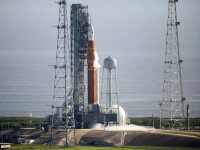
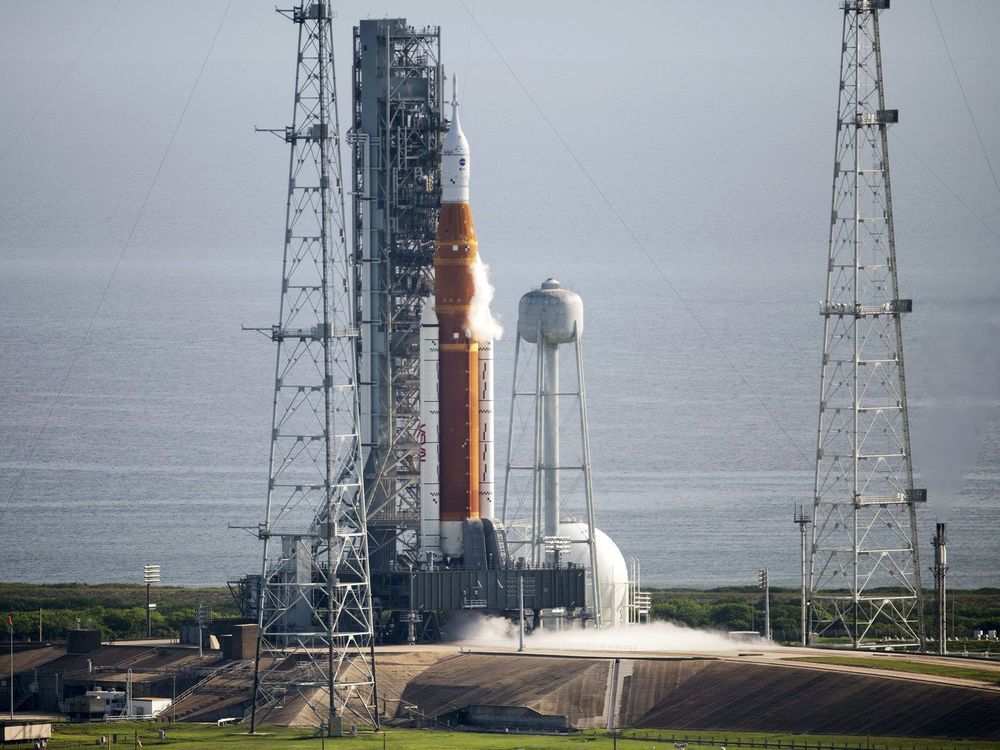
 torontosun.com
torontosun.com
Author of the article:Reuters
Reuters
Joey Roulette and Steve Gorman
Publishing date:Sep 03, 2022 • 9 hours ago • 4 minute read • Join the conversation
In this NASA handout, NASA's Space Launch System (SLS) rocket with the Orion spacecraft aboard is seen atop the mobile launcher at Launch Pad 39B, as the Artemis I launch teams load more than 700,000 gallons of cryogenic propellants including liquid hydrogen and liquid oxygen as the launch countdown progresses at Kennedy Space Center on Sept. 3, 2022 in Cape Canaveral, Fla.
In this NASA handout, NASA's Space Launch System (SLS) rocket with the Orion spacecraft aboard is seen atop the mobile launcher at Launch Pad 39B, as the Artemis I launch teams load more than 700,000 gallons of cryogenic propellants including liquid hydrogen and liquid oxygen as the launch countdown progresses at Kennedy Space Center on Sept. 3, 2022 in Cape Canaveral, Fla. PHOTO BY NASA /Photographer: NASA/Getty Images
CAPE CANAVERAL — For the second time in a week, NASA on Saturday aborted an attempt to launch its giant, next-generation rocketship, citing a stubborn fuel leak that the space agency said could delay the debut mission of its moon-to-Mars Artemis program by at least several weeks.
Preflight operations were called off for the day about three hours before the 2:17 p.m. EDT liftoff time targeted for the 32-story-tall Space Launch System (SLS) rocket and its Orion capsule from Cape Canaveral, Florida.
The uncrewed test flight, aimed at launching the capsule out to the moon and back, was to have marked the inaugural voyage of both the SLS and Orion a half century after the last lunar mission of Apollo, forerunner of the Artemis program.
The countdown was scrubbed after Kennedy Space Center technicians made three failed attempts to fix a “large” leak of supercooled liquid hydrogen propellant being pumped into the rocket’s core-stage fuel tanks, agency officials said.
NASA’s next-generation moon rocket, the Space Launch System (SLS), with the Orion crew capsule, is seen on launch complex 39B after its launch on the Artemis 1 mission was delayed, at Cape Canaveral, Fla., Sept. 3, 2022.
NASA’s next-generation moon rocket, the Space Launch System (SLS), with the Orion crew capsule, is seen on launch complex 39B after its launch on the Artemis 1 mission was delayed, at Cape Canaveral, Fla., Sept. 3, 2022. PHOTO BY THOM BAUR /REUTERS
The initial launch try on Monday was likewise foiled by technical problems, including a different leaky fuel line, a faulty temperature sensor and cracks found in insulation foam.
Mission managers proceeded with a second launch attempt on Saturday once the earlier issues had been resolved to their satisfaction. And NASA had reserved another backup launch time, for either Monday or Tuesday, in case a third try was needed.
But after a review of data from the latest difficulties, NASA concluded the new hydrogen leak was too tricky and time-consuming to finish troubleshooting and fix on the launch pad before the current launch period allotted to the mission expires on Tuesday.
The delay means the earliest opportunity to try again would come during the next launch period that runs Sept. 19-30, or during a subsequent October window, an associate NASA administrator, Jim Free, told reporters at a late-afternoon briefing.
He said the postponement also would involve rolling the spacecraft back into its assembly building, under Cape Canaveral “range” rules limiting how long a rocket may remain at its launch tower before undergoing a new round of safety checks indoors.
Mike Sarafin, NASA’s Artemis mission manager, said efforts to resolve the latest technical snag would entail “several weeks of work.”
NASA chief Bill Nelson said earlier in the day that a rollback would postpone the next launch attempt at least until mid-October, in part to avoid a scheduling conflict with the next International Space Station crew due for launch early that month.
Launch-day delays and malfunctions are not uncommon in the space business, especially for new rockets such as NASA’s Space Launch System, a complex vehicle with a set of pre-liftoff procedures that have yet to be fully tested and rehearsed by engineers without a hitch.
On average, the odds of scrubbing a launch on any given day for any reason, including foul weather, are about one-in-three.
“We’re not going to launch until it’s right, and that is standard operating procedure, and will continue to be,” Nelson said at the briefing.
The last-minute setbacks on the launchpad came at the tail end of a development program more than a decade in the making, with years of delays and billions of dollars in cost overruns under NASA’s respective SLS and Orion contracts with Boeing Co and Lockheed Martin Corp.
MOON TO MARS
Apart from its technical challenges, Artemis I signals a major turning point for NASA’s post-Apollo human spaceflight program, after decades focused on low-Earth orbit with space shuttles and the International Space Station.
Named for the goddess who was Apollo’s twin sister in ancient Greek mythology, Artemis aims to return astronauts to the moon’s surface as early as 2025, though many experts believe that time frame will likely slip.
Twelve astronauts walked on the moon during six Apollo missions from 1969 to 1972, the only spaceflights yet to place humans on the lunar surface. But Apollo, born of the U.S.-Soviet space race during the Cold War, was less science-driven than Artemis.
The new moon program has enlisted commercial partners such as SpaceX and the space agencies of Europe, Canada and Japan to eventually establish a long-term lunar base of operations as a stepping stone to even more ambitious human voyages to Mars.
Getting the SLS-Orion spacecraft launched is a key first step. Its first voyage is intended to put the 5.75-million-pound vehicle through its paces in a rigorous test flight pushing its design limits and aiming to prove the spacecraft suitable to fly astronauts.
If the mission succeeds, a crewed Artemis II flight around the moon and back could come as early as 2024, to be followed within a few more years with the program’s first lunar landing of astronauts, one of them a woman, with Artemis III.
Billed as the most powerful, complex rocket in the world, the SLS represents the biggest new vertical launch system NASA has built since the Saturn V of the Apollo era.
Although no humans will be aboard, Orion will carry a simulated crew of three – one male and two female mannequins – fitted with sensors to measure radiation levels and other stresses that real-life astronauts would experience.


NASA calls off retry of Artemis moon rocket launch, citing fuel leak
For the second time, NASA on Saturday halted a countdown in progress and postponed a planned attempt to launch its rocket to the moon.
Canadian astronaut says Artemis 1 delay right call; next try weeks away
Author of the article:Canadian Press
Canadian Press
Sidhartha Banerjee
Publishing date:Sep 04, 2022 • 19 hours ago • 3 minute read • Join the conversation
Photographers pack up their equipment as NASA's new moon rocket sits on Launch Pad 39-B after being scrubbed at the Kennedy Space Center, in Cape Canaveral, Fla., Saturday, Sept. 3, 2022. Canadian astronaut David Saint-Jacques says the scrubbing of the Artemis moon rocket launch today is disappointing, but necessary.
Photographers pack up their equipment as NASA's new moon rocket sits on Launch Pad 39-B after being scrubbed at the Kennedy Space Center, in Cape Canaveral, Fla., Saturday, Sept. 3, 2022. Canadian astronaut David Saint-Jacques says the scrubbing of the Artemis moon rocket launch today is disappointing, but necessary. PHOTO BY CHRIS O'MEARA /THE ASSOCIATED PRESS
MONTREAL — NASA’s decision to scrub the launch of its new moon rocket is disappointing but necessary due to another leak found ahead of the planned test flight, Canadian astronaut David Saint-Jacques said Saturday.
The Artemis 1 mission, which aims to send an uncrewed NASA Orion spacecraft and Space Launch System rocket to the moon, was delayed after the rocket sprang a fuel leak, forcing controllers to call off the second attempt this week.
Monday’s first effort to send a crew capsule with test dummies aboard into lunar orbit was also aborted due to escaping hydrogen elsewhere on the 98-metre NASA-built rocket.
After the latest setback, mission managers decided to haul the rocket off the pad and move into the hangar for further repairs and system updates. Several weeks of work will be needed, according to officials.
The test flight is slated to be the first return to the moon after almost 50 years.
Saint-Jacques, who was set to watch the launch from the Canadian Space Agency headquarters in suburban Montreal, said the excited space buff in him was disappointed but the sober engineer knows it was the right call.
“It’s the right thing to do, there’s no need to rush to launch,” Saint-Jacques said.
It wasn’t immediately clear when NASA may try again. Saint-Jacques said a window remains open until about Tuesday, but after that the moon won’t be in the right spot in the sky for a few weeks.
NASA administrator Bill Nelson said Saturday the launch will be off until October if the rocket has to return to the hangar for repairs.
The $4.1 billion test flight is the first step in NASA’s Artemis program of renewed lunar exploration, named after the twin sister of Apollo in Greek mythology.
Saint-Jacques said the test flight is an important one, noting a Canadian astronaut is expected to be part of Artemis 2, the first crewed flight since Apollo 17 in 1972, which is slated to fly around the moon and return in 2024.
The flight would make Canada the second country ever to send someone around the moon.
“That’ll be huge for our nation,” Saint-Jacques said. “Everyone remembers where they were when Neil Armstrong set foot on the moon, well I think everyone will remember where they were when a Canadian launches for the moon.”
Canada is also contributing Canadaarm 3 to the Lunar Gateway, a planned orbiting lunar space station set to be a key part of the Artemis program. Canadian researchers and firms are involved in the program as well.
Saint-Jacques said the Artemis program will reintroduce humans to the lunar environment, but also provides a training ground for missions to Mars. The first step, however, is to get the Artemis 1 mission off the launch pad so scientists can learn everything they need to from the test run.
Federal Innovation, Science and Industry Minister Francois-Philippe Champagne released a statement on Saturday expressing his disappointment.
“Like many Canadians, I’m anxiously waiting for a successful launch of Artemis I. But as you know, this is a very complex mission and it’s important to see this done safely and to do this right,” Champagne said.
“We’ve waited almost 50 years for humans to go back to the moon, so whether it’s waiting a few days or a few weeks, Canada will be front and centre in humanity’s next steps in space exploration.”
This report by The Canadian Press was first published Sept. 3, 2022.
— with files from The Associated Press.
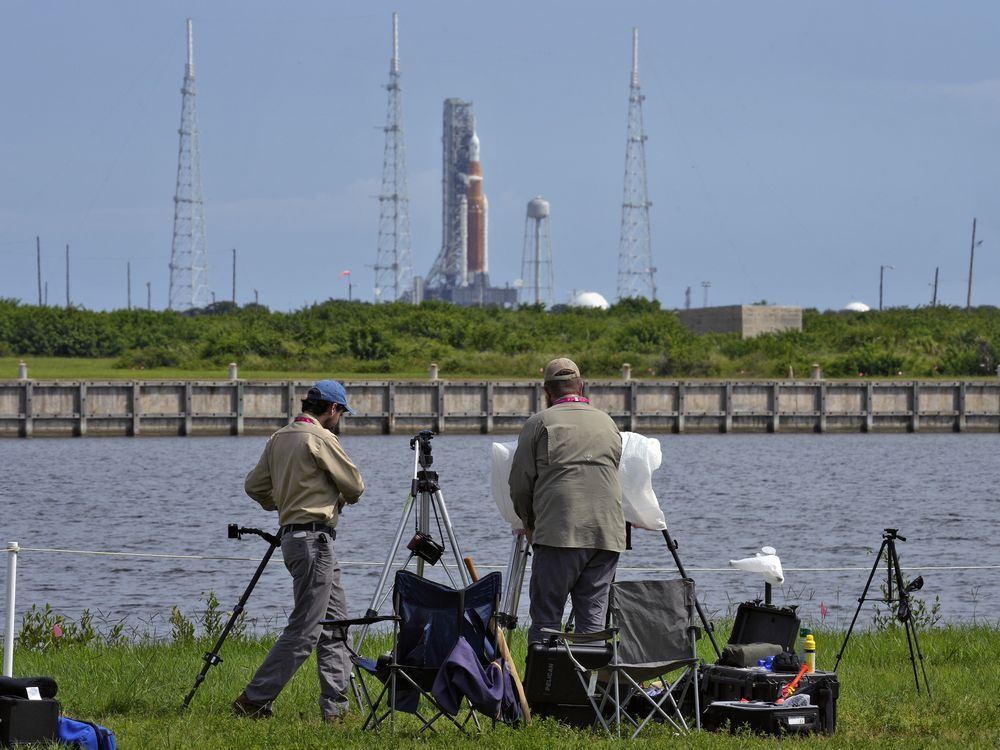
 torontosun.com
torontosun.com
Author of the article:Canadian Press
Canadian Press
Sidhartha Banerjee
Publishing date:Sep 04, 2022 • 19 hours ago • 3 minute read • Join the conversation
Photographers pack up their equipment as NASA's new moon rocket sits on Launch Pad 39-B after being scrubbed at the Kennedy Space Center, in Cape Canaveral, Fla., Saturday, Sept. 3, 2022. Canadian astronaut David Saint-Jacques says the scrubbing of the Artemis moon rocket launch today is disappointing, but necessary.
Photographers pack up their equipment as NASA's new moon rocket sits on Launch Pad 39-B after being scrubbed at the Kennedy Space Center, in Cape Canaveral, Fla., Saturday, Sept. 3, 2022. Canadian astronaut David Saint-Jacques says the scrubbing of the Artemis moon rocket launch today is disappointing, but necessary. PHOTO BY CHRIS O'MEARA /THE ASSOCIATED PRESS
MONTREAL — NASA’s decision to scrub the launch of its new moon rocket is disappointing but necessary due to another leak found ahead of the planned test flight, Canadian astronaut David Saint-Jacques said Saturday.
The Artemis 1 mission, which aims to send an uncrewed NASA Orion spacecraft and Space Launch System rocket to the moon, was delayed after the rocket sprang a fuel leak, forcing controllers to call off the second attempt this week.
Monday’s first effort to send a crew capsule with test dummies aboard into lunar orbit was also aborted due to escaping hydrogen elsewhere on the 98-metre NASA-built rocket.
After the latest setback, mission managers decided to haul the rocket off the pad and move into the hangar for further repairs and system updates. Several weeks of work will be needed, according to officials.
The test flight is slated to be the first return to the moon after almost 50 years.
Saint-Jacques, who was set to watch the launch from the Canadian Space Agency headquarters in suburban Montreal, said the excited space buff in him was disappointed but the sober engineer knows it was the right call.
“It’s the right thing to do, there’s no need to rush to launch,” Saint-Jacques said.
It wasn’t immediately clear when NASA may try again. Saint-Jacques said a window remains open until about Tuesday, but after that the moon won’t be in the right spot in the sky for a few weeks.
NASA administrator Bill Nelson said Saturday the launch will be off until October if the rocket has to return to the hangar for repairs.
The $4.1 billion test flight is the first step in NASA’s Artemis program of renewed lunar exploration, named after the twin sister of Apollo in Greek mythology.
Saint-Jacques said the test flight is an important one, noting a Canadian astronaut is expected to be part of Artemis 2, the first crewed flight since Apollo 17 in 1972, which is slated to fly around the moon and return in 2024.
The flight would make Canada the second country ever to send someone around the moon.
“That’ll be huge for our nation,” Saint-Jacques said. “Everyone remembers where they were when Neil Armstrong set foot on the moon, well I think everyone will remember where they were when a Canadian launches for the moon.”
Canada is also contributing Canadaarm 3 to the Lunar Gateway, a planned orbiting lunar space station set to be a key part of the Artemis program. Canadian researchers and firms are involved in the program as well.
Saint-Jacques said the Artemis program will reintroduce humans to the lunar environment, but also provides a training ground for missions to Mars. The first step, however, is to get the Artemis 1 mission off the launch pad so scientists can learn everything they need to from the test run.
Federal Innovation, Science and Industry Minister Francois-Philippe Champagne released a statement on Saturday expressing his disappointment.
“Like many Canadians, I’m anxiously waiting for a successful launch of Artemis I. But as you know, this is a very complex mission and it’s important to see this done safely and to do this right,” Champagne said.
“We’ve waited almost 50 years for humans to go back to the moon, so whether it’s waiting a few days or a few weeks, Canada will be front and centre in humanity’s next steps in space exploration.”
This report by The Canadian Press was first published Sept. 3, 2022.
— with files from The Associated Press.

Canadian astronaut says Artemis 1 delay right call; next try weeks away
NASA's decision to scrub the launch of its new moon rocket is disappointing but necessary, Canadian astronaut David Saint-Jacques said.
Meteor streaking across U.K. reported by hundreds of eyewitnesses
Author of the article:Liz Braun
Publishing date:Sep 15, 2022 • 9 hours ago • 1 minute read • Join the conversation
A meteor streaks across the sky above Scotland on Wednesday, Sept. 14, 2022.
A meteor streaks across the sky above Scotland on Wednesday, Sept. 14, 2022. PHOTO BY UK METEOR NETWORK /Twitter
A fireball spotted over Scotland and reported as a meteorite caught the attention of many as it streaked across a huge swath of the U.K.
Hundreds of sightings were called into the UK Meteor Network on Wednesday night.
The New York post reports the object as a meteor “so low you could heart it” as reports poured in from people who both saw the fireball and heard it streaking across the sky.
And people reported hearing a loud bang as it entered the atmosphere.
One person in Motherwell, Scotland took to social media with footage they captured of the object flying downward.
The suspected meteor was reportedly heading from the southwest over Ireland and across to Scotland.
On Thursday, Sky News reported experts had come to believe the “brilliant fireball” lighting up the sky was space debris. And they believe it finally landed in the Atlantic, south of the Hebrides.
One eyewitness was Steve Owens, astronomer and science communicator at the Glasgow Science Centre, who saw the object over Scotland.
He told the BBC how brilliant the object was.
“I could see that it was fragmenting, breaking apart, there were little bits coming off it,” he said. “And normally, if you see a meteor or a shooting star, they are just tiny little streaks of light, they last for a fraction of a second.”
“This one was streaking across the sky for at least 10 seconds — probably longer than that — and it travelled from due south all the way across to the west, so it was a pretty incredible sight,” Owens added.
The UK Meteor Network tweeted out pictures and some of the video captured of the object.
And late Thursday, they confirmed via Twitter that the object was in fact a meteor.
They also stated that the object ended up over the North Atlantic, about 50 to 100 km west of the Isle of Islay.
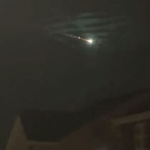

 news.sky.com
news.sky.com

 nypost.com
nypost.com
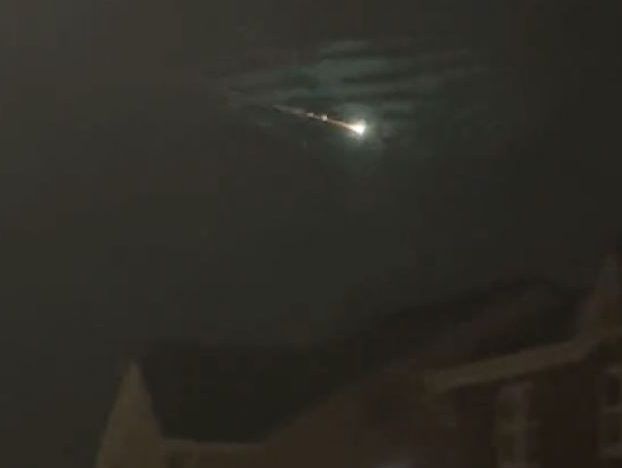
 torontosun.com
torontosun.com
Author of the article:Liz Braun
Publishing date:Sep 15, 2022 • 9 hours ago • 1 minute read • Join the conversation
A meteor streaks across the sky above Scotland on Wednesday, Sept. 14, 2022.
A meteor streaks across the sky above Scotland on Wednesday, Sept. 14, 2022. PHOTO BY UK METEOR NETWORK /Twitter
A fireball spotted over Scotland and reported as a meteorite caught the attention of many as it streaked across a huge swath of the U.K.
Hundreds of sightings were called into the UK Meteor Network on Wednesday night.
The New York post reports the object as a meteor “so low you could heart it” as reports poured in from people who both saw the fireball and heard it streaking across the sky.
And people reported hearing a loud bang as it entered the atmosphere.
One person in Motherwell, Scotland took to social media with footage they captured of the object flying downward.
The suspected meteor was reportedly heading from the southwest over Ireland and across to Scotland.
On Thursday, Sky News reported experts had come to believe the “brilliant fireball” lighting up the sky was space debris. And they believe it finally landed in the Atlantic, south of the Hebrides.
One eyewitness was Steve Owens, astronomer and science communicator at the Glasgow Science Centre, who saw the object over Scotland.
He told the BBC how brilliant the object was.
“I could see that it was fragmenting, breaking apart, there were little bits coming off it,” he said. “And normally, if you see a meteor or a shooting star, they are just tiny little streaks of light, they last for a fraction of a second.”
“This one was streaking across the sky for at least 10 seconds — probably longer than that — and it travelled from due south all the way across to the west, so it was a pretty incredible sight,” Owens added.
The UK Meteor Network tweeted out pictures and some of the video captured of the object.
And late Thursday, they confirmed via Twitter that the object was in fact a meteor.
They also stated that the object ended up over the North Atlantic, about 50 to 100 km west of the Isle of Islay.


'Brilliant fireball' that lit up the night sky over parts of Britain was space debris, experts say
The UK Meteor Network gathered more than 200 reports from eye witnesses seeing a meteorite in the sky over Wednesday night.

Meteor ‘so low you could hear it’ streaks across Scotland, crashes with bang
Hope they remembered to make a wish on this once-in-a-lifetime shooting star.

Meteor streaking across U.K. reported by hundreds of eyewitnesses
A fireball spotted over Scotland and reported as a meteorite caught the attention of many as it streaked across a huge swath of the U.K.
NASA tries fueling moon rocket in test, but leak reoccurs
Author of the article:Associated Press
Associated Press
Marcia Dunn
Publishing date:Sep 21, 2022 • 21 hours ago • 2 minute read • Join the conversation
CAPE CANAVERAL, Fla. — NASA’s new moon rocket sprouted another fuel leak Wednesday as engineers tested the plumbing ahead of a launch attempt as early as next week.
The daylong demo had barely begun when hazardous hydrogen fuel began escaping at the same place and same time as before, despite new seals and other repairs. Engineers halted the flow and warmed the lines in hopes of plugging the leak, and proceeded with the test. But the leak persisted.
Wednesday’s results will determine whether the 322-foot (98-metre) rocket is ready for its first test flight, a lunar-orbiting mission with mannequins instead of astronauts.
Hydrogen leaks spoiled the first two launch attempts, as well as earlier countdown tests. So much hydrogen escaped during the countdown earlier this month that it exceeded NASA’s limit by more than double. Wednesday’s leak came close to the limit, but the launch team managed to get the leak down to acceptable levels as the test continued.
After the previous delay, NASA replaced two seals. One had a tiny indentation; it measured a mere one-hundredth of an inch.
“Now that doesn’t sound like a lot, but again we’re dealing with hydrogen,” the smallest element on the periodic table, said mission manager Mike Sarafin.
Wednesday’s objective: pumping nearly 1 million gallons (4 million litres) into the rocket, with minimum leakage. That would put NASA on course for a possible launch attempt Tuesday, provided the U.S. Space Force extends the certification of batteries on board that are part of the flight safety system.
Besides replacing seals, NASA altered the fueling process, easing more slowly into the loading of the super-cold liquid hydrogen and oxygen. After Wednesday’s leak appeared, the launch team moved even more slowly to subject the plumbing to even less stress.
Once launched, the crew capsule atop the rocket will be the first to orbit the moon in 50 years. The $4.1 billion mission should last more than five weeks, ending with a splashdown in the Pacific. Astronauts would climb aboard for the second test flight, dashing around the moon in 2024. The third mission, targeted for 2025, would see a pair of astronauts actually landing on the moon.
NASA’s Space Launch System rocket is more powerful than the Saturn V rocket that sent Apollo astronauts to the moon during the late 1960s and early 1970s. The engines and boosters are carryovers from the now retired space shuttles. Just like now, NASA struggled with elusive hydrogen leaks during the shuttle era, especially during the early 1990s.
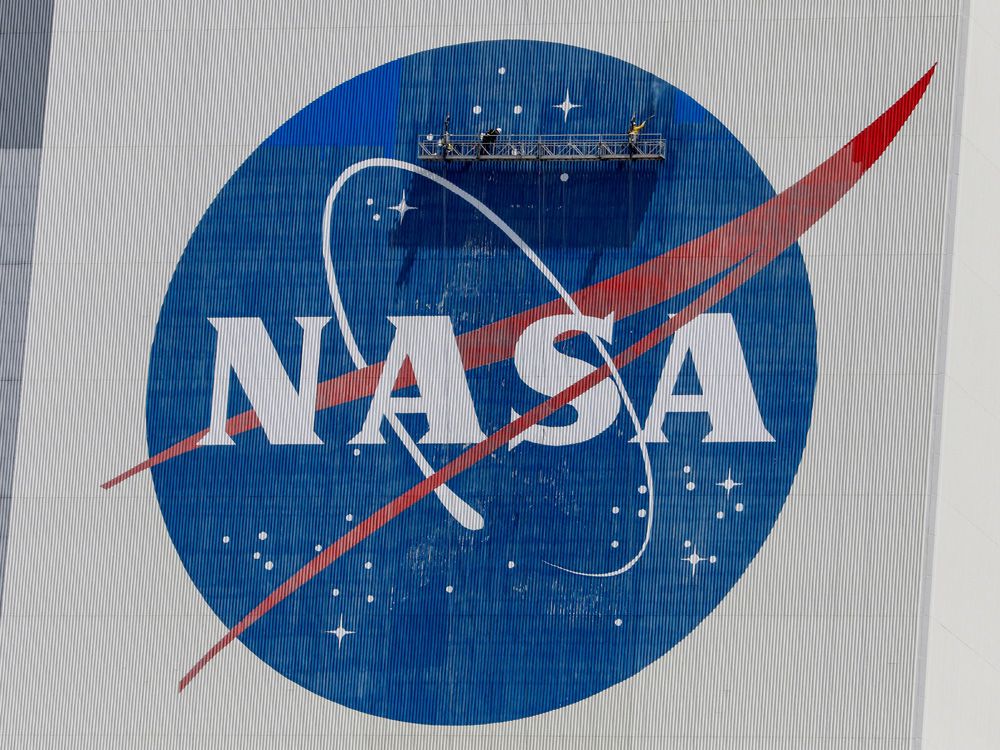
 torontosun.com
torontosun.com
Author of the article:Associated Press
Associated Press
Marcia Dunn
Publishing date:Sep 21, 2022 • 21 hours ago • 2 minute read • Join the conversation
CAPE CANAVERAL, Fla. — NASA’s new moon rocket sprouted another fuel leak Wednesday as engineers tested the plumbing ahead of a launch attempt as early as next week.
The daylong demo had barely begun when hazardous hydrogen fuel began escaping at the same place and same time as before, despite new seals and other repairs. Engineers halted the flow and warmed the lines in hopes of plugging the leak, and proceeded with the test. But the leak persisted.
Wednesday’s results will determine whether the 322-foot (98-metre) rocket is ready for its first test flight, a lunar-orbiting mission with mannequins instead of astronauts.
Hydrogen leaks spoiled the first two launch attempts, as well as earlier countdown tests. So much hydrogen escaped during the countdown earlier this month that it exceeded NASA’s limit by more than double. Wednesday’s leak came close to the limit, but the launch team managed to get the leak down to acceptable levels as the test continued.
After the previous delay, NASA replaced two seals. One had a tiny indentation; it measured a mere one-hundredth of an inch.
“Now that doesn’t sound like a lot, but again we’re dealing with hydrogen,” the smallest element on the periodic table, said mission manager Mike Sarafin.
Wednesday’s objective: pumping nearly 1 million gallons (4 million litres) into the rocket, with minimum leakage. That would put NASA on course for a possible launch attempt Tuesday, provided the U.S. Space Force extends the certification of batteries on board that are part of the flight safety system.
Besides replacing seals, NASA altered the fueling process, easing more slowly into the loading of the super-cold liquid hydrogen and oxygen. After Wednesday’s leak appeared, the launch team moved even more slowly to subject the plumbing to even less stress.
Once launched, the crew capsule atop the rocket will be the first to orbit the moon in 50 years. The $4.1 billion mission should last more than five weeks, ending with a splashdown in the Pacific. Astronauts would climb aboard for the second test flight, dashing around the moon in 2024. The third mission, targeted for 2025, would see a pair of astronauts actually landing on the moon.
NASA’s Space Launch System rocket is more powerful than the Saturn V rocket that sent Apollo astronauts to the moon during the late 1960s and early 1970s. The engines and boosters are carryovers from the now retired space shuttles. Just like now, NASA struggled with elusive hydrogen leaks during the shuttle era, especially during the early 1990s.

NASA tries fueling moon rocket in test, but leak reoccurs
CAPE CANAVERAL, Fla. — NASA’s new moon rocket sprouted another fuel leak Wednesday as engineers tested the plumbing ahead of a launch attempt as early as next week.
Why is a NASA spacecraft crashing into an asteroid?
Author of the article:Associated Press
Associated Press
Marcia Dunn
Publishing date:Sep 22, 2022 • 12 hours ago • 5 minute read • Join the conversation
NASA's DART spacecraft will blast off to asteroid Didymos to crash into its moon.
NASA's DART spacecraft will blast off to asteroid Didymos to crash into its moon. PHOTO BY NASA
CAPE CANAVERAL, Fla. — In the first-of-its kind, save-the-world experiment, NASA is about to clobber a small, harmless asteroid millions of miles away.
A spacecraft named Dart will zero in on the asteroid Monday, intent on slamming it head-on at 22,500 km/h. The impact should be just enough to nudge the asteroid into a slightly tighter orbit around its companion space rock — demonstrating that if a killer asteroid ever heads our way, we’d stand a fighting chance of diverting it.
“This is stuff of science-fiction books and really corny episodes of “StarTrek” from when I was a kid, and now it’s real,” NASA program scientist Tom Statler said Thursday.
Cameras and telescopes will watch the crash, but it will take days or even weeks to find out if it actually changed the orbit.
The $325 million planetary defence test began with Dart’s launch last fall.
ASTEROID TARGET
The asteroid with the bull’s-eye on it is Dimorphos, about 9.6 million kilometres from Earth. It is actually the puny sidekick of a 2,500-foot (780-metre) asteroid named Didymos, Greek for twin. Discovered in 1996, Didymos is spinning so fast that scientists believe it flung off material that eventually formed a moonlet. Dimorphos — roughly 525 feet (160 metres) across — orbits its parent body at a distance of less than a mile (1.2 kilometres).
A placard hangs on the wall during the Double Asteroid Redirection Test (DART) Technology Media Workshop Telecon Briefing and tour at the Johns Hopkins Applied Physics Laboratory in Laurel, Maryland, on Sept. 12, 2022, ahead of the Sept. 26 project test mission.
A placard hangs on the wall during the Double Asteroid Redirection Test (DART) Technology Media Workshop Telecon Briefing and tour at the Johns Hopkins Applied Physics Laboratory in Laurel, Maryland, on Sept. 12, 2022, ahead of the Sept. 26 project test mission. PHOTO BY JIM WATSON /AFP via Getty Images
“This really is about asteroid deflection, not disruption,” said Nancy Chabot, a planetary scientist and mission team leader at Johns Hopkins University’s Applied Physics Laboratory, which is managing the effort. “This isn’t going to blow up the asteroid. It isn’t going to put it into lots of pieces.” Rather, the impact will dig out a crater tens of yards (metres) in size and hurl some 2 million pounds (1 million kilograms) of rocks and dirt into space.
NASA insists there’s a zero chance either asteroid will threaten Earth — now or in the future. That’s why the pair was picked.
DART, THE IMPACTOR
The Johns Hopkins lab took a minimalist approach in developing Dart — short for Double Asteroid Redirection Test — given that it’s essentially a battering ram and faces sure destruction. It has a single instrument: a camera used for navigating, targeting and chronicling the final action. Believed to be essentially a rubble pile, Dimorphos will emerge as a point of light an hour before impact, looming larger and larger in the camera images beamed back to Earth. Managers are confident Dart won’t smash into the larger Didymos by mistake. The spacecraft’s navigation is designed to distinguish between the two asteroids and, in the final 50 minutes, target the smaller one.
The size of a small vending machine at 1,260 pounds (570 kilograms), the spacecraft will slam into roughly 11 billion pounds (5 billion kilograms) of asteroid. “Sometimes we describe it as running a golf cart into a Great Pyramid,” said Chabot.
Unless Dart misses — NASA puts the odds of that happening at less than 10% — it will be the end of the road for Dart. If it goes screaming past both space rocks, it will encounter them again in a couple years for Take 2.
SAVING EARTH
Little Dimorphos completes a lap around big Didymos every 11 hours and 55 minutes. The impact by Dart should shave about 10 minutes off that. Although the strike itself should be immediately apparent, it could take a few weeks or more to verify the moonlet’s tweaked orbit. Cameras on Dart and a mini tagalong satellite will capture the collision up close. Telescopes on all seven continents, along with the Hubble and Webb space telescopes and NASA’s asteroid-hunting Lucy spacecraft, may see a bright flash as Dart smacks Dimorphos and sends streams of rock and dirt cascading into space. The observatories will track the pair of asteroids as they circle the sun, to see if Dart altered Dimorphos’ orbit. In 2024, a European spacecraft named Hera will retrace Dart’s journey to measure the impact results.
Although the intended nudge should change the moonlet’s position only slightly, that will add up to a major shift over time, according to Chabot. “So if you were going to do this for planetary defense, you would do it five, 10, 15, 20 years in advance in order for this technique to work,” she said. Even if Dart misses, the experiment still will provide valuable insight, said NASA program executive Andrea Riley. “This is why we test. We want to do it now rather than when there’s an actual need,” she said.
ASTEROID MISSIONS GALORE
Planet Earth is on an asteroid-chasing roll. NASA has close to a pound (450 grams) of rubble collected from asteroid Bennu headed to Earth. The stash should arrive next September. Japan was the first to retrieve asteroid samples, accomplishing the feat twice. China hopes to follow suit with a mission launching in 2025. NASA’s Lucy spacecraft, meanwhile, is headed to asteroids near Jupiter, after launching last year. Another spacecraft, Near-Earth Asteroid Scout, is loaded into NASA’s new moon rocket awaiting liftoff; it will use a solar sail to fly past a space rock that’s less than 60 feet (18 metres) next year. In the next few years, NASA also plans to launch a census-taking telescope to identify hard-to-find asteroids that could pose risks. One asteroid mission is grounded while an independent review board weighs its future. NASA’s Psyche spacecraft should have launched this year to a metal-rich asteroid between Mars and Jupiter, but the team couldn’t test the flight software in time.
HOLLYWOOD’S TAKE
Hollywood has churned out dozens of killer-space-rock movies over the decades, including 1998â²s “Armageddon” which brought Bruce Willis to Cape Canaveral for filming, and last year’s “Don’t Look Up” with Leonardo DiCaprio leading an all-star cast. NASA’s planetary defense officer, Lindley Johnson, figures he’s seen them all since 1979â²s “Meteor,” his personal favorite “since Sean Connery played me.” While some of the sci-fi films are more accurate than others, he noted, entertainment always wins out. The good news is that the coast seems clear for the next century, with no known threats. Otherwise, “it would be like the movies, right?” said NASA’s science mission chief Thomas Zurbuchen. What’s worrisome, though, are the unknown threats. Fewer than half of the 460-foot (140-metre) objects have been confirmed, with millions of smaller but still-dangerous objects zooming around. “These threats are real, and what makes this time special, is we can do something about it,” Zurbuchen said. Not by blowing up an asteroid as Willis’ character did — that would be a last, last-minute resort — or by begging government leaders to take action as DiCaprio’s character did in vain. If time allows, the best tactic could be to nudge the menacing asteroid out of our way, like Dart.
——
The Associated Press Health and Science Department receives support from the Howard Hughes Medical Institute’s Department of Science Education. The AP is solely responsible for all content.
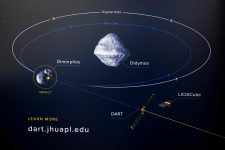
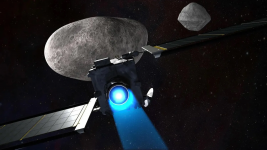
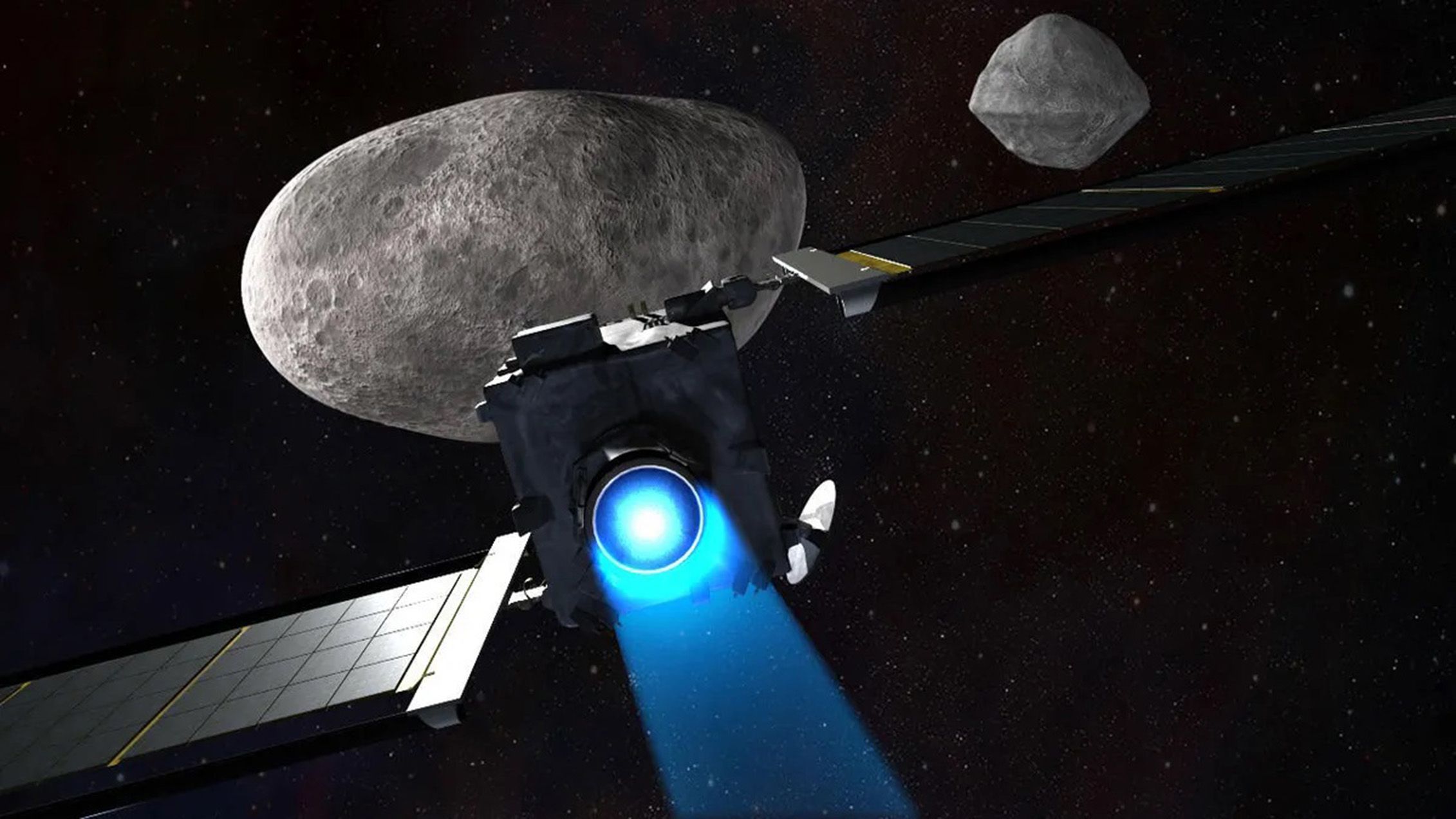
 torontosun.com
torontosun.com
Author of the article:Associated Press
Associated Press
Marcia Dunn
Publishing date:Sep 22, 2022 • 12 hours ago • 5 minute read • Join the conversation
NASA's DART spacecraft will blast off to asteroid Didymos to crash into its moon.
NASA's DART spacecraft will blast off to asteroid Didymos to crash into its moon. PHOTO BY NASA
CAPE CANAVERAL, Fla. — In the first-of-its kind, save-the-world experiment, NASA is about to clobber a small, harmless asteroid millions of miles away.
A spacecraft named Dart will zero in on the asteroid Monday, intent on slamming it head-on at 22,500 km/h. The impact should be just enough to nudge the asteroid into a slightly tighter orbit around its companion space rock — demonstrating that if a killer asteroid ever heads our way, we’d stand a fighting chance of diverting it.
“This is stuff of science-fiction books and really corny episodes of “StarTrek” from when I was a kid, and now it’s real,” NASA program scientist Tom Statler said Thursday.
Cameras and telescopes will watch the crash, but it will take days or even weeks to find out if it actually changed the orbit.
The $325 million planetary defence test began with Dart’s launch last fall.
ASTEROID TARGET
The asteroid with the bull’s-eye on it is Dimorphos, about 9.6 million kilometres from Earth. It is actually the puny sidekick of a 2,500-foot (780-metre) asteroid named Didymos, Greek for twin. Discovered in 1996, Didymos is spinning so fast that scientists believe it flung off material that eventually formed a moonlet. Dimorphos — roughly 525 feet (160 metres) across — orbits its parent body at a distance of less than a mile (1.2 kilometres).
A placard hangs on the wall during the Double Asteroid Redirection Test (DART) Technology Media Workshop Telecon Briefing and tour at the Johns Hopkins Applied Physics Laboratory in Laurel, Maryland, on Sept. 12, 2022, ahead of the Sept. 26 project test mission.
A placard hangs on the wall during the Double Asteroid Redirection Test (DART) Technology Media Workshop Telecon Briefing and tour at the Johns Hopkins Applied Physics Laboratory in Laurel, Maryland, on Sept. 12, 2022, ahead of the Sept. 26 project test mission. PHOTO BY JIM WATSON /AFP via Getty Images
“This really is about asteroid deflection, not disruption,” said Nancy Chabot, a planetary scientist and mission team leader at Johns Hopkins University’s Applied Physics Laboratory, which is managing the effort. “This isn’t going to blow up the asteroid. It isn’t going to put it into lots of pieces.” Rather, the impact will dig out a crater tens of yards (metres) in size and hurl some 2 million pounds (1 million kilograms) of rocks and dirt into space.
NASA insists there’s a zero chance either asteroid will threaten Earth — now or in the future. That’s why the pair was picked.
DART, THE IMPACTOR
The Johns Hopkins lab took a minimalist approach in developing Dart — short for Double Asteroid Redirection Test — given that it’s essentially a battering ram and faces sure destruction. It has a single instrument: a camera used for navigating, targeting and chronicling the final action. Believed to be essentially a rubble pile, Dimorphos will emerge as a point of light an hour before impact, looming larger and larger in the camera images beamed back to Earth. Managers are confident Dart won’t smash into the larger Didymos by mistake. The spacecraft’s navigation is designed to distinguish between the two asteroids and, in the final 50 minutes, target the smaller one.
The size of a small vending machine at 1,260 pounds (570 kilograms), the spacecraft will slam into roughly 11 billion pounds (5 billion kilograms) of asteroid. “Sometimes we describe it as running a golf cart into a Great Pyramid,” said Chabot.
Unless Dart misses — NASA puts the odds of that happening at less than 10% — it will be the end of the road for Dart. If it goes screaming past both space rocks, it will encounter them again in a couple years for Take 2.
SAVING EARTH
Little Dimorphos completes a lap around big Didymos every 11 hours and 55 minutes. The impact by Dart should shave about 10 minutes off that. Although the strike itself should be immediately apparent, it could take a few weeks or more to verify the moonlet’s tweaked orbit. Cameras on Dart and a mini tagalong satellite will capture the collision up close. Telescopes on all seven continents, along with the Hubble and Webb space telescopes and NASA’s asteroid-hunting Lucy spacecraft, may see a bright flash as Dart smacks Dimorphos and sends streams of rock and dirt cascading into space. The observatories will track the pair of asteroids as they circle the sun, to see if Dart altered Dimorphos’ orbit. In 2024, a European spacecraft named Hera will retrace Dart’s journey to measure the impact results.
Although the intended nudge should change the moonlet’s position only slightly, that will add up to a major shift over time, according to Chabot. “So if you were going to do this for planetary defense, you would do it five, 10, 15, 20 years in advance in order for this technique to work,” she said. Even if Dart misses, the experiment still will provide valuable insight, said NASA program executive Andrea Riley. “This is why we test. We want to do it now rather than when there’s an actual need,” she said.
ASTEROID MISSIONS GALORE
Planet Earth is on an asteroid-chasing roll. NASA has close to a pound (450 grams) of rubble collected from asteroid Bennu headed to Earth. The stash should arrive next September. Japan was the first to retrieve asteroid samples, accomplishing the feat twice. China hopes to follow suit with a mission launching in 2025. NASA’s Lucy spacecraft, meanwhile, is headed to asteroids near Jupiter, after launching last year. Another spacecraft, Near-Earth Asteroid Scout, is loaded into NASA’s new moon rocket awaiting liftoff; it will use a solar sail to fly past a space rock that’s less than 60 feet (18 metres) next year. In the next few years, NASA also plans to launch a census-taking telescope to identify hard-to-find asteroids that could pose risks. One asteroid mission is grounded while an independent review board weighs its future. NASA’s Psyche spacecraft should have launched this year to a metal-rich asteroid between Mars and Jupiter, but the team couldn’t test the flight software in time.
HOLLYWOOD’S TAKE
Hollywood has churned out dozens of killer-space-rock movies over the decades, including 1998â²s “Armageddon” which brought Bruce Willis to Cape Canaveral for filming, and last year’s “Don’t Look Up” with Leonardo DiCaprio leading an all-star cast. NASA’s planetary defense officer, Lindley Johnson, figures he’s seen them all since 1979â²s “Meteor,” his personal favorite “since Sean Connery played me.” While some of the sci-fi films are more accurate than others, he noted, entertainment always wins out. The good news is that the coast seems clear for the next century, with no known threats. Otherwise, “it would be like the movies, right?” said NASA’s science mission chief Thomas Zurbuchen. What’s worrisome, though, are the unknown threats. Fewer than half of the 460-foot (140-metre) objects have been confirmed, with millions of smaller but still-dangerous objects zooming around. “These threats are real, and what makes this time special, is we can do something about it,” Zurbuchen said. Not by blowing up an asteroid as Willis’ character did — that would be a last, last-minute resort — or by begging government leaders to take action as DiCaprio’s character did in vain. If time allows, the best tactic could be to nudge the menacing asteroid out of our way, like Dart.
——
The Associated Press Health and Science Department receives support from the Howard Hughes Medical Institute’s Department of Science Education. The AP is solely responsible for all content.



Why is a NASA spacecraft crashing into an asteroid?
In the first-of-its kind, save-the-world experiment, NASA is about to clobber a small, harmless asteroid millions of miles away.
The recently launched super space telescope James Webb has returned spectacular new imagery of Neptune.
The observatory's infrared instruments highlight features not seen in such detail since the Voyager 2 probe flew past the planet in 1989.
These include the rings and dust bands that encircle the ice giant.
Scientists are also intrigued by the different cloud structures, which should tell them something novel about the workings of Neptune's atmosphere.
Beyond the planet itself are seven of the giant's 14 moons, the most significant of which is Triton.
It appears star-like in the Webb imagery.
That's because Neptune is darkened in the telescope's view by methane absorption at infrared wavelengths.
Triton, on the other hand, reflects an average of 70% of the sunlight that strikes its icy surface. It's very bright.
Prof Leigh Fletcher, from Leicester University, is at the Europlanet Science Congress in Granada, Spain, where everyone is "trying to interpret this on our phones, but it's incredible to see those rings, and we're accessing wavelengths that no-one has seen before".
"Its great to see how excited everyone is!" he told BBC News.
"The longer wavelengths are brand new and could give us a window on to the deep circulation patterns, with a bright equatorial band that looks a bit like the bright bands of Jupiter and Saturn.
"Neptune's powerful storms are as active as ever, and the whole Neptune family is represented here, with those ring moons and Triton."
Neptune is the outermost planet in our Solar System, beyond Uranus and Saturn, but inside the dwarf planet Pluto.
It circles the Sun at a distance of roughly 4.5 billion km, and takes 164.8 years to complete one revolution.
Like the other outer Solar System giants, its atmosphere contains a lot of hydrogen and helium. But there is a very strong presence of ices, of water, ammonia and methane.
Neptune's diameter is close to 50,000km, or almost four times that of Earth.
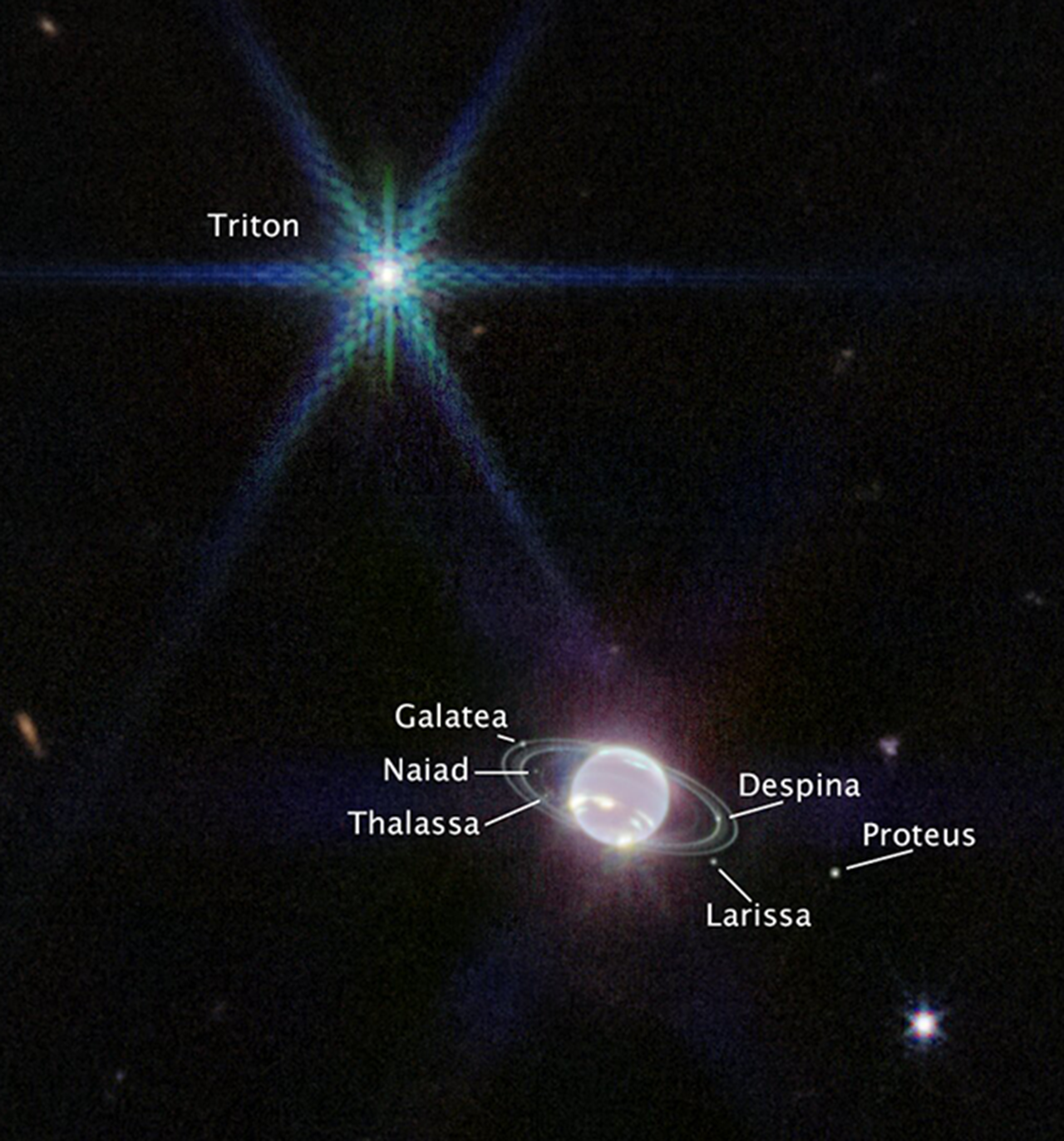
The ice giant Neptune has a total of 14 moons, the largest of which is the geologically active Triton
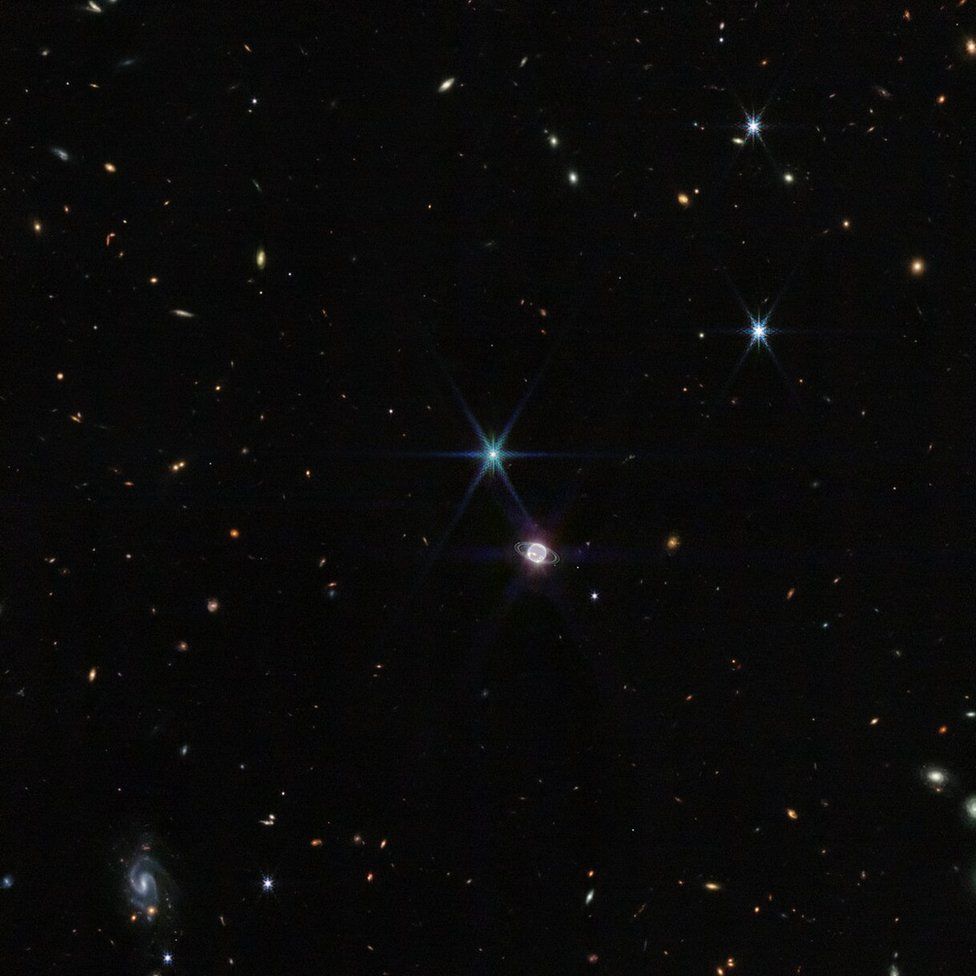
In the widefield view, it's possible to see the oval and spiral shapes of galaxies beyond our Milky Way
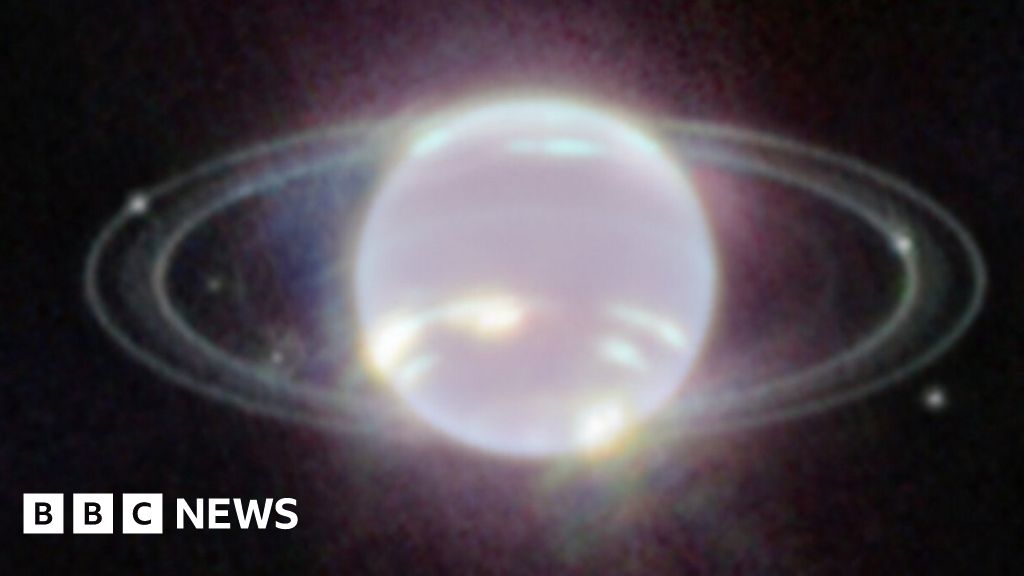
The observatory's infrared instruments highlight features not seen in such detail since the Voyager 2 probe flew past the planet in 1989.
These include the rings and dust bands that encircle the ice giant.
Scientists are also intrigued by the different cloud structures, which should tell them something novel about the workings of Neptune's atmosphere.
Beyond the planet itself are seven of the giant's 14 moons, the most significant of which is Triton.
It appears star-like in the Webb imagery.
That's because Neptune is darkened in the telescope's view by methane absorption at infrared wavelengths.
Triton, on the other hand, reflects an average of 70% of the sunlight that strikes its icy surface. It's very bright.
Prof Leigh Fletcher, from Leicester University, is at the Europlanet Science Congress in Granada, Spain, where everyone is "trying to interpret this on our phones, but it's incredible to see those rings, and we're accessing wavelengths that no-one has seen before".
"Its great to see how excited everyone is!" he told BBC News.
"The longer wavelengths are brand new and could give us a window on to the deep circulation patterns, with a bright equatorial band that looks a bit like the bright bands of Jupiter and Saturn.
"Neptune's powerful storms are as active as ever, and the whole Neptune family is represented here, with those ring moons and Triton."
Neptune is the outermost planet in our Solar System, beyond Uranus and Saturn, but inside the dwarf planet Pluto.
It circles the Sun at a distance of roughly 4.5 billion km, and takes 164.8 years to complete one revolution.
Like the other outer Solar System giants, its atmosphere contains a lot of hydrogen and helium. But there is a very strong presence of ices, of water, ammonia and methane.
Neptune's diameter is close to 50,000km, or almost four times that of Earth.

The ice giant Neptune has a total of 14 moons, the largest of which is the geologically active Triton

In the widefield view, it's possible to see the oval and spiral shapes of galaxies beyond our Milky Way

Ringed Neptune captured by James Webb telescope
The super space observatory returns spectacular imagery of the Solar System's most distant planet.
www.bbc.co.uk
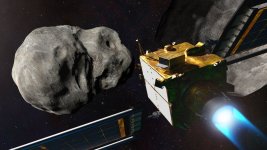
In the coming hours, the American space agency will crash a probe into an asteroid.
Nasa's Dart mission wants to see how difficult it would be to stop a sizeable space rock from hitting Earth.
The demonstration is taking place some 11 million km away (7 million miles) on a target called Dimorphos.
The agency says the rock is not currently on a path to hit the Earth, nor will the test accidentally send it in our direction.
The impact is timed for 23:14 GMT, Monday (00:14 BST, Tuesday).
Telescopes will be watching from afar, including the new super space observatory James Webb.
We've all seen how Hollywood would do it, with brave astronauts and nuclear weapons. But how do you protect Earth from a killer asteroid for real?
Nasa is about to find out. Its idea is simply to smash a spacecraft into one.
The thinking is you would only need to change the rock's velocity by a small amount to alter its path so that it misses Earth - provided you do it far enough in advance.
The Double Asteroid Redirection Test (Dart) mission will check out this theory with a near-head-on crash into 160m-wide Dimorphos at over 20,000km/h.
This should change its orbit around a much larger asteroid, called Didymos, by just a few minutes every day.
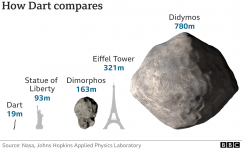
Nasa is promising some spectacular images from the 570kg-Dart probe as it goes in for the hit.
"Dart is the first planetary defence test mission to demonstrate running a spacecraft into an asteroid to move the position of that asteroid ever so slightly in space," explained Dr Nancy Chabot from the Johns Hopkins University Applied Physics Laboratory, which leads the mission for Nasa.
"This is the sort of thing, if you needed to, that you would do years in advance to just give the asteroid a small nudge to change its future position so that the Earth and the asteroid wouldn't be on a collision course," she told BBC News.
Hitting Dimorphos will be quite the challenge. It's only in the last 50 minutes or so that Dart will be able to distinguish its target from 780m-wide Didymos.
Navigation software must then adjust the spacecraft's trajectory to make a direct hit.
"Because of the speed of light and the distances involved, it's really not feasible for there to be a pilot sitting on the ground with a stick controlling the spacecraft. There just isn't enough time to respond," said Dr Tom Statler, the Dart programme scientist at Nasa.
"We've had to develop software that can interpret images taken by the spacecraft, figure out what is the right target and make the course correction manoeuvres by firing thrusters."
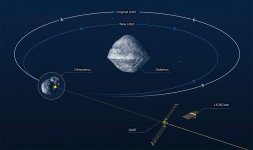
Dart will be returning images to Earth at the rate of one per second as it heads towards its "deep impact". What at first will appear as a dot of light in the pictures will quickly grow to fill the entire field of view, before the feed then suddenly cuts out as the spacecraft is destroyed.
Fortunately, that's not the end of the story. Dart has carried with it a 14kg Italian cubesat that was released some days ago. Its job is to record what happens when Dart digs out a crater.
Its pictures, snapped from the safe distance of 50km, will be beamed back to Earth over the coming days.
"LiciaCube will pass about three minutes after Dart's impact," said Simone Pirrotta from the Italian space agency (ASI).
"This timing has been selected in order to allow the plume of ejecta to be completely developed, because one of the major contributions of LiciaCube is to document the plume to support the measurement of the parameters that confirm the deflection of the orbit."
Currently, Dimorphos takes roughly 11 hours and 55 minutes to circle Didymos.
The impact is expected to change the smaller object's momentum such that the orbital period is reduced to something in the order of 11 hours and 45 minutes.
Telescope measurements will confirm this in the weeks and months ahead.
Surveys of the sky combined with statistical analyses suggest we have identified more than 95% of the monster asteroids that could initiate a global extinction were they to collide with Earth (they won't; their paths have been computed and they won't come near our planet). But this still leaves many so-far undetected smaller objects that could create havoc, if only on the regional or city scale.
An object like Dimorphos, were it to hit Earth (it won't), might dig out a crater perhaps 1km across and a couple of hundred meters deep. The damage in the vicinity of the impact would be intense.
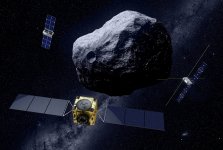
Four years from now, the European Space Agency (Esa) will have three spacecraft - collectively known as the Hera mission - at Didymos and Dimorphos to make follow-up studies.

Nasa spacecraft lining up to smash into an asteroid
The Dart mission will test a technique for defending the Earth against hazardous space rocks.
Hurricane Ian prompts NASA to roll moon rocket off launchpad
Author of the article:Reuters
Reuters
Publishing date:Sep 26, 2022 • 19 hours ago • 1 minute read • Join the conversation
In this handout image courtesy of NASA the NASAs Space Launch System (SLS) rocket with the Orion spacecraft aboard is seen atop the mobile launcher at Launch Pad 39B as teams configure systems for rolling back to the Vehicle Assembly Building, Sept. 24, 2022, at NASAs Kennedy Space Center in Florida.
In this handout image courtesy of NASA the NASAs Space Launch System (SLS) rocket with the Orion spacecraft aboard is seen atop the mobile launcher at Launch Pad 39B as teams configure systems for rolling back to the Vehicle Assembly Building, Sept. 24, 2022, at NASAs Kennedy Space Center in Florida. PHOTO BY JOEL KOWSKY/NASA /AFP via Getty Images
CAPE CANAVERAL, Fla. — Hurricane Ian is prompting NASA to move its moon rocket off the launch pad and into shelter, adding weeks of delay to the lunar-orbiting test flight.
Mission managers decided Monday to return the rocket to its Kennedy Space Center hangar. The four-mile trip will begin late Monday night and could take as long as 12 hours.
The space center remained on the fringes of the hurricane’s cone of uncertainty. With the latest forecast showing no improvement, managers decided to play it safe. NASA already had delayed this week’s planned launch attempt because of the approaching storm.
NASA isn’t speculating when the next launch attempt might be, but it could be off until November. Managers will assess their options once the 322-foot (98-meter) Space Launch System rocket is safely back in the hangar.
A pair of launch attempts were thwarted by hydrogen fuel leaks and other technical trouble.
The $4.1 billion test flight will kick off NASA’s return to the moon since the Apollo moonshots of the 1960s and 1970s. No one will be inside the crew capsule for the debut launch. Astronauts will strap in for the second mission in 2024, leading to a two-person moon landing in 2025.
Meanwhile, NASA and SpaceX are still targeting an Oct. 3 launch of a crew from the U.S., Russia and Japan to the International Space Station. But managers acknowledged that the flight could be delayed as Kennedy braces for the hurricane and its aftermath.
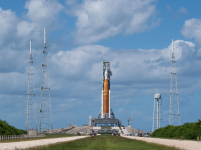
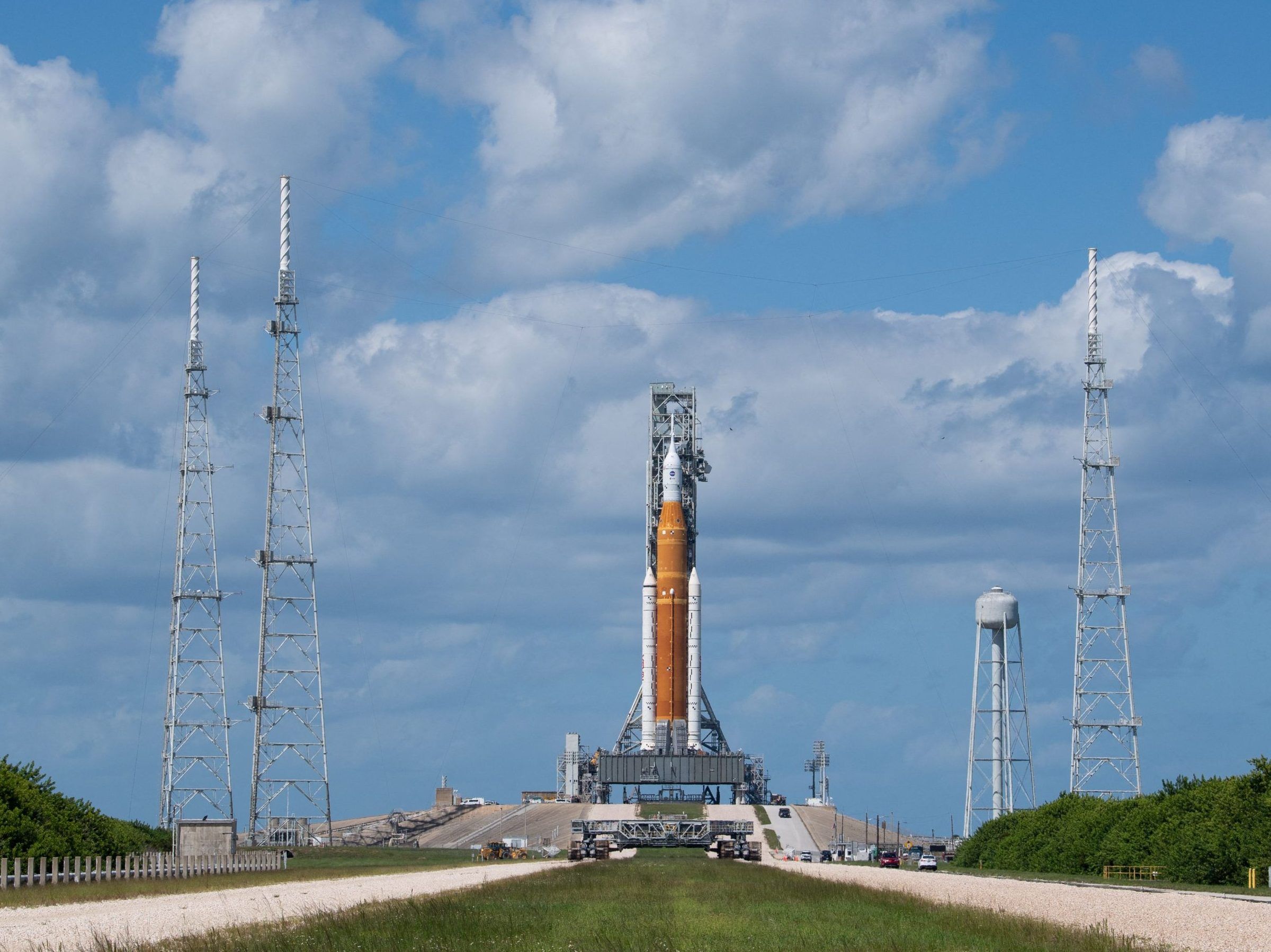
 torontosun.com
torontosun.com
Author of the article:Reuters
Reuters
Publishing date:Sep 26, 2022 • 19 hours ago • 1 minute read • Join the conversation
In this handout image courtesy of NASA the NASAs Space Launch System (SLS) rocket with the Orion spacecraft aboard is seen atop the mobile launcher at Launch Pad 39B as teams configure systems for rolling back to the Vehicle Assembly Building, Sept. 24, 2022, at NASAs Kennedy Space Center in Florida.
In this handout image courtesy of NASA the NASAs Space Launch System (SLS) rocket with the Orion spacecraft aboard is seen atop the mobile launcher at Launch Pad 39B as teams configure systems for rolling back to the Vehicle Assembly Building, Sept. 24, 2022, at NASAs Kennedy Space Center in Florida. PHOTO BY JOEL KOWSKY/NASA /AFP via Getty Images
CAPE CANAVERAL, Fla. — Hurricane Ian is prompting NASA to move its moon rocket off the launch pad and into shelter, adding weeks of delay to the lunar-orbiting test flight.
Mission managers decided Monday to return the rocket to its Kennedy Space Center hangar. The four-mile trip will begin late Monday night and could take as long as 12 hours.
The space center remained on the fringes of the hurricane’s cone of uncertainty. With the latest forecast showing no improvement, managers decided to play it safe. NASA already had delayed this week’s planned launch attempt because of the approaching storm.
NASA isn’t speculating when the next launch attempt might be, but it could be off until November. Managers will assess their options once the 322-foot (98-meter) Space Launch System rocket is safely back in the hangar.
A pair of launch attempts were thwarted by hydrogen fuel leaks and other technical trouble.
The $4.1 billion test flight will kick off NASA’s return to the moon since the Apollo moonshots of the 1960s and 1970s. No one will be inside the crew capsule for the debut launch. Astronauts will strap in for the second mission in 2024, leading to a two-person moon landing in 2025.
Meanwhile, NASA and SpaceX are still targeting an Oct. 3 launch of a crew from the U.S., Russia and Japan to the International Space Station. But managers acknowledged that the flight could be delayed as Kennedy braces for the hurricane and its aftermath.


Hurricane Ian prompts NASA to roll moon rocket off launchpad
NASA on Monday said it will roll its giant moon rocket off its launchpad in Florida and back to the assembly building due to Hurricane Ian.
Bam! NASA spacecraft crashes into asteroid in defence test
Author of the article:Associated Press
Associated Press
Publishing date:Sep 26, 2022 • 16 hours ago • 3 minute read • 25 Comments
NASA's Double Asteroid Redirection Test (DART) spacecraft prior to impact at the Didymos binary asteroid system showed in this undated illustration handout.
NASA's Double Asteroid Redirection Test (DART) spacecraft prior to impact at the Didymos binary asteroid system showed in this undated illustration handout. PHOTO BY NASA/JOHNS HOPKINS /Handout via REUTERS
CAPE CANAVERAL, Fla. — A NASA spacecraft rammed an asteroid at blistering speed Monday in an unprecedented dress rehearsal for the day a killer rock menaces Earth.
The galactic grand slam occurred at a harmless asteroid 7 million miles (9.6 million kilometres) away, with the spacecraft named Dart plowing into the small space rock at 14,000 mph (22,500 kph). Scientists expected the impact to carve out a crater, hurl streams of rocks and dirt into space and, most importantly, alter the asteroid’s orbit.
“We have impact!” Mission Control’s Elena Adams announced, jumping up and down and thrusting her arms skyward.
Telescopes around the world and in space aimed at the same point in the sky to capture the spectacle. Though the impact was immediately obvious — Dart’s radio signal abruptly ceased — it will be days or even weeks to determine how much the asteroid’s path was changed.
“Now is when the science starts,” said NASA’s Lori Glaze, planetary science division director. “Now we’re going to see for real how efffective we were.”
The $325 million mission was the first attempt to shift the position of an asteroid or any other natural object in space.
“No, this is not a movie plot,” NASA Administrator Bill Nelson tweeted earlier in the day. ”We’ve all seen it on movies like ‘Armageddon,’ but the real-life stakes are high,” he said in a prerecorded video.
Monday’s target: a 525-foot (160-metre) asteroid named Dimorphos. It’s actually a moonlet of Didymos, Greek for twin, a fast-spinning asteroid five times bigger that flung off the material that formed the junior partner.
The pair have been orbiting the sun for eons without threatening Earth, making them ideal save-the-world test candidates.
Launched last November, the vending machine-size Dart — short for Double Asteroid Redirection Test — navigated to its target using new technology developed by Johns Hopkins University’s Applied Physics Laboratory, the spacecraft builder and mission manager.
Dart’s on-board camera, a key part of this smart navigation system, caught sight of Dimorphos barely an hour before impact.
“Woo hoo,” exclaimed Johns Hopkins mission systems engineer Elena Adams. “We’re seeing Dimorphos, so wonderful, wonderful.”
With an image beaming back to Earth every second, Adams and other ground controllers in Laurel, Maryland, watched with growing excitement as Dimorphos loomed larger and larger in the field of view alongside its bigger companion.
A mini satellite followed a few minutes behind to take photos of the impact. The Italian Cubesat was released from Dart two weeks ago.
Scientists insisted Dart would not shatter Dimorphos. The spacecraft packed a scant 1,260 pounds (570 kilograms), compared with the asteroid’s 11 billion pounds (5 billion kilograms). But that should be plenty to shrink its 11-hour, 55-minute orbit around Didymos.
The impact should pare 10 minutes off that, but telescopes will need anywhere from a few days to nearly a month to verify the new orbit. The anticipated orbital shift of 1% might not sound like much, scientists noted. But they stressed it would amount to a significant change over years.
Planetary defense experts prefer nudging a threatening asteroid or comet out of the way, given enough lead time, rather than blowing it up and creating multiple pieces that could rain down on Earth. Multiple impactors might be needed for big space rocks or a combination of impactors and so-called gravity tractors, not-yet-invented devices that would use their own gravity to pull an asteroid into a safer orbit.
“The dinosaurs didn’t have a space program to help them know what was coming, but we do,” NASA’s senior climate adviser Katherine Calvin said, referring to the mass extinction 66 million years ago believed to have been caused by a major asteroid impact, volcanic eruptions or both.
The non-profit B612 Foundation, dedicated to protecting Earth from asteroid strikes, has been pushing for impact tests like Dart since its founding by astronauts and physicists 20 years ago. Monday’s feat aside, the world must do a better job of identifying the countless space rocks lurking out there, warned the foundation’s executive director, Ed Lu, a former astronaut.
Significantly less than half of the estimated 25,000 near-Earth objects in the deadly 460-foot (140-metre) range have been discovered, according to NASA. And fewer than 1% of the millions of smaller asteroids, capable of widespread injuries, are known.
The Vera Rubin Observatory, nearing completion in Chile by the National Science Foundation and U.S. Energy Department, promises to revolutionize the field of asteroid discovery, Lu noted.
Finding and tracking asteroids, “That’s still the name of the game here. That’s the thing that has to happen in order to protect the Earth,” he said.
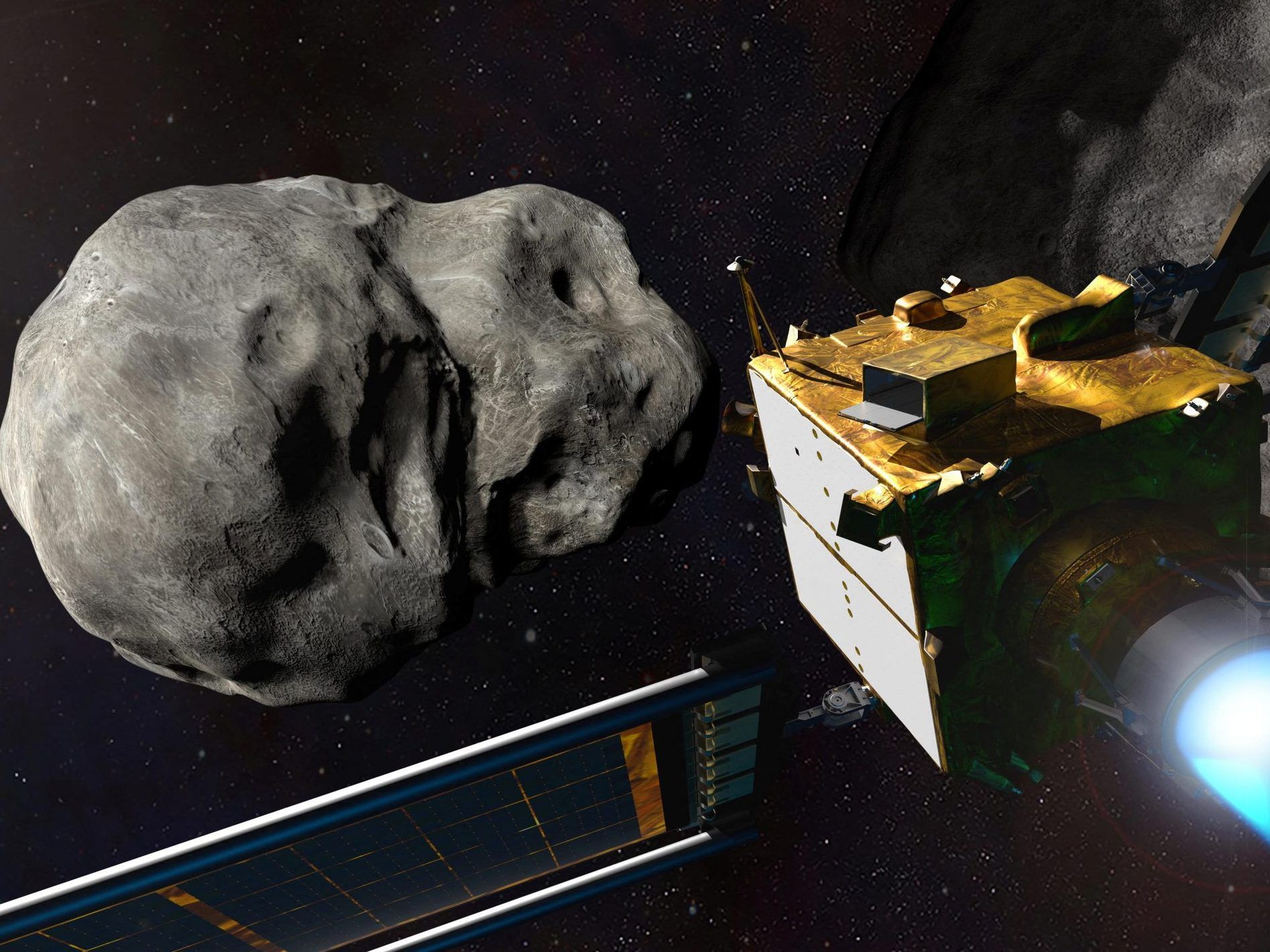
 torontosun.com
torontosun.com
Author of the article:Associated Press
Associated Press
Publishing date:Sep 26, 2022 • 16 hours ago • 3 minute read • 25 Comments
NASA's Double Asteroid Redirection Test (DART) spacecraft prior to impact at the Didymos binary asteroid system showed in this undated illustration handout.
NASA's Double Asteroid Redirection Test (DART) spacecraft prior to impact at the Didymos binary asteroid system showed in this undated illustration handout. PHOTO BY NASA/JOHNS HOPKINS /Handout via REUTERS
CAPE CANAVERAL, Fla. — A NASA spacecraft rammed an asteroid at blistering speed Monday in an unprecedented dress rehearsal for the day a killer rock menaces Earth.
The galactic grand slam occurred at a harmless asteroid 7 million miles (9.6 million kilometres) away, with the spacecraft named Dart plowing into the small space rock at 14,000 mph (22,500 kph). Scientists expected the impact to carve out a crater, hurl streams of rocks and dirt into space and, most importantly, alter the asteroid’s orbit.
“We have impact!” Mission Control’s Elena Adams announced, jumping up and down and thrusting her arms skyward.
Telescopes around the world and in space aimed at the same point in the sky to capture the spectacle. Though the impact was immediately obvious — Dart’s radio signal abruptly ceased — it will be days or even weeks to determine how much the asteroid’s path was changed.
“Now is when the science starts,” said NASA’s Lori Glaze, planetary science division director. “Now we’re going to see for real how efffective we were.”
The $325 million mission was the first attempt to shift the position of an asteroid or any other natural object in space.
“No, this is not a movie plot,” NASA Administrator Bill Nelson tweeted earlier in the day. ”We’ve all seen it on movies like ‘Armageddon,’ but the real-life stakes are high,” he said in a prerecorded video.
Monday’s target: a 525-foot (160-metre) asteroid named Dimorphos. It’s actually a moonlet of Didymos, Greek for twin, a fast-spinning asteroid five times bigger that flung off the material that formed the junior partner.
The pair have been orbiting the sun for eons without threatening Earth, making them ideal save-the-world test candidates.
Launched last November, the vending machine-size Dart — short for Double Asteroid Redirection Test — navigated to its target using new technology developed by Johns Hopkins University’s Applied Physics Laboratory, the spacecraft builder and mission manager.
Dart’s on-board camera, a key part of this smart navigation system, caught sight of Dimorphos barely an hour before impact.
“Woo hoo,” exclaimed Johns Hopkins mission systems engineer Elena Adams. “We’re seeing Dimorphos, so wonderful, wonderful.”
With an image beaming back to Earth every second, Adams and other ground controllers in Laurel, Maryland, watched with growing excitement as Dimorphos loomed larger and larger in the field of view alongside its bigger companion.
A mini satellite followed a few minutes behind to take photos of the impact. The Italian Cubesat was released from Dart two weeks ago.
Scientists insisted Dart would not shatter Dimorphos. The spacecraft packed a scant 1,260 pounds (570 kilograms), compared with the asteroid’s 11 billion pounds (5 billion kilograms). But that should be plenty to shrink its 11-hour, 55-minute orbit around Didymos.
The impact should pare 10 minutes off that, but telescopes will need anywhere from a few days to nearly a month to verify the new orbit. The anticipated orbital shift of 1% might not sound like much, scientists noted. But they stressed it would amount to a significant change over years.
Planetary defense experts prefer nudging a threatening asteroid or comet out of the way, given enough lead time, rather than blowing it up and creating multiple pieces that could rain down on Earth. Multiple impactors might be needed for big space rocks or a combination of impactors and so-called gravity tractors, not-yet-invented devices that would use their own gravity to pull an asteroid into a safer orbit.
“The dinosaurs didn’t have a space program to help them know what was coming, but we do,” NASA’s senior climate adviser Katherine Calvin said, referring to the mass extinction 66 million years ago believed to have been caused by a major asteroid impact, volcanic eruptions or both.
The non-profit B612 Foundation, dedicated to protecting Earth from asteroid strikes, has been pushing for impact tests like Dart since its founding by astronauts and physicists 20 years ago. Monday’s feat aside, the world must do a better job of identifying the countless space rocks lurking out there, warned the foundation’s executive director, Ed Lu, a former astronaut.
Significantly less than half of the estimated 25,000 near-Earth objects in the deadly 460-foot (140-metre) range have been discovered, according to NASA. And fewer than 1% of the millions of smaller asteroids, capable of widespread injuries, are known.
The Vera Rubin Observatory, nearing completion in Chile by the National Science Foundation and U.S. Energy Department, promises to revolutionize the field of asteroid discovery, Lu noted.
Finding and tracking asteroids, “That’s still the name of the game here. That’s the thing that has to happen in order to protect the Earth,” he said.

Bam! NASA spacecraft crashes into asteroid in defence test
A NASA spacecraft rammed an asteroid at blistering speed Monday in an unprecedented dress rehearsal for the day a killer rock menaces Earth.
NASA asteroid strike results in big nudge
Author of the article:Associated Press
Associated Press
Marcia Dunn
Publishing date:Oct 11, 2022 • 17 hours ago • 3 minute read • Join the conversation
This combination of images provided by NASA shows three different views of the DART spacecraft impact on the asteroid Dimorphos on Monday, Sept. 26, 2022.
This combination of images provided by NASA shows three different views of the DART spacecraft impact on the asteroid Dimorphos on Monday, Sept. 26, 2022. PHOTO BY NASA /THE ASSOCIATED PRESS
CAPE CANAVERAL, Fla. — A spacecraft that plowed into a small, harmless asteroid millions of miles away succeeded in shifting its orbit, NASA said Tuesday in announcing the results of its save-the-world test.
The space agency attempted the test two weeks ago to see if in the future a killer rock could be nudged out of Earth’s way.
“This mission shows that NASA is trying to be ready for whatever the universe throws at us,” NASA Administrator Bill Nelson said during a briefing at the space agency’s headquarters in Washington.
The Dart spacecraft carved a crater into the asteroid Dimorphos on Sept. 26, hurling debris out into space and creating a cometlike trail of dust and rubble stretching several thousand miles (kilometres). It took consecutive nights of telescope observations from Chile and South Africa to determine how much the impact altered the path of the 525-foot (160-metre) asteroid around its companion, a much bigger space rock.
Before the impact, the moonlet took 11 hours and 55 minutes to circle its parent asteroid. Scientists had anticipated shaving off 10 minutes, but Nelson said the impact shortened the asteroid’s orbit by 32 minutes.
“Let’s all just kind of take a moment to soak this in … for the first time ever, humanity has changed the orbit” of a celestial body, noted Lori Glaze, NASA’s director of planetary science.
Apollo astronaut Rusty Schweickart, a co-founder of the nonprofit B612 Foundation, dedicated to protecting Earth from asteroid strikes, said he’s “clearly delighted, no question about that” by the results and the attention the mission has brought to asteroid deflection.
The team’s scientists said the amount of debris apparently played a role in the outcome. The impact may also have left Dimorphos wobbling a bit, said NASA program scientist Tom Statler. That may affect the orbit, but it will never go back to its original location, he noted.
The two bodies originally were already less than a mile (1.2 kilometres) apart. Now they’re tens of yards (metres) closer.
Neither asteroid posed a threat to Earth — and still don’t as they continue their journey around the sun. That’s why scientists picked the pair for this all-important dress rehearsal.
Planetary defence experts prefer nudging a threatening asteroid or comet out of the way, given years or even decades of lead time, rather than blowing it up and creating multiple pieces that could rain down on Earth.
“We really need to also have that warning time for a technique like this to be effective,” said mission leader Nancy Chabot of Johns Hopkins University’s Applied Physics Laboratory, which built the spacecraft and managed the $325 million mission.
“You’ve got to know they’re coming,” added Glaze.
Launched last year, the vending machine-size Dart — short for Double Asteroid Redirection Test — was destroyed when it slammed into the asteroid 7 million miles (11 million kilometres) away at 14,000 mph (22,500 km/h).
“This is huge feat, not only in achieving the first step in possibly being able to protect ourselves from future asteroid impacts,” but also for the amount of images and data collected internationally, Daniel Brown, an astronomer at Nottingham Trent University in England, said via email.
Brown also said that it’s “particularly exciting” that the debris tail can be seen by amateur skygazers with medium-size telescopes.
Team scientists cautioned more work is needed to not only identify more of the countless space rocks out there, but to ascertain their makeup — some are solid, while others are rubble piles. Scouting missions might be needed, for instance, before launching impactors to deflect the orbits.
“We should not be too eager to say one test on one asteroid tells us exactly how every other asteroid would behave in a similar situation,” Statler said.
Nonetheless, he and others are rejoicing over this first effort.
”We’ve been imagining this for years and to have it finally be real is really quite a thrill,” he said.
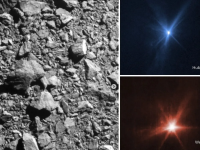
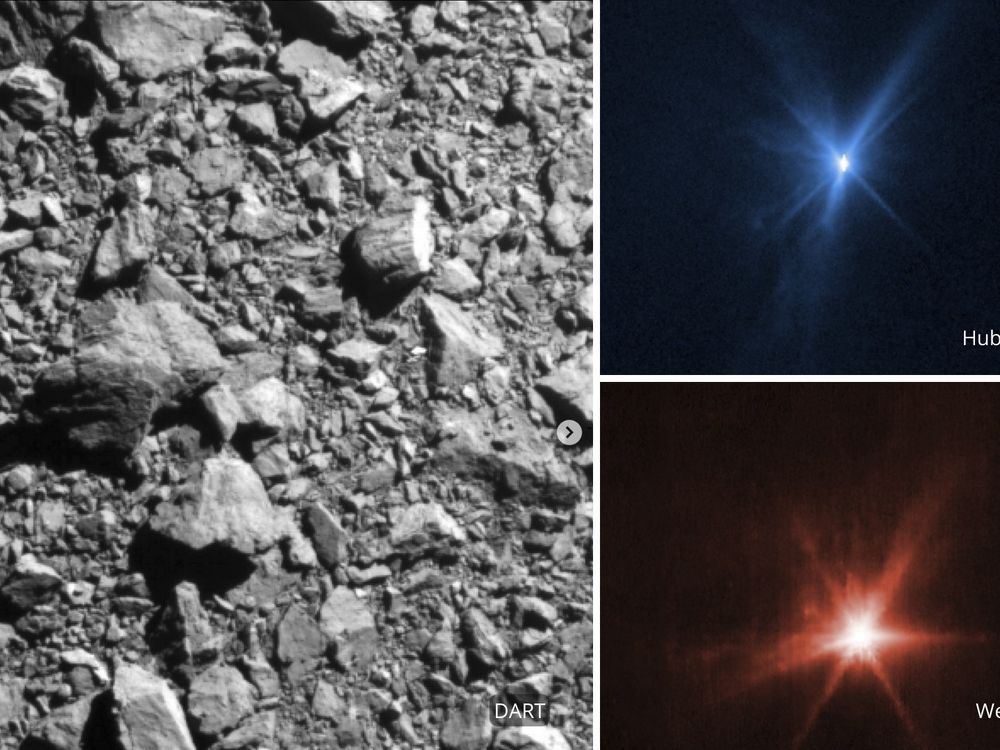
 torontosun.com
torontosun.com
Author of the article:Associated Press
Associated Press
Marcia Dunn
Publishing date:Oct 11, 2022 • 17 hours ago • 3 minute read • Join the conversation
This combination of images provided by NASA shows three different views of the DART spacecraft impact on the asteroid Dimorphos on Monday, Sept. 26, 2022.
This combination of images provided by NASA shows three different views of the DART spacecraft impact on the asteroid Dimorphos on Monday, Sept. 26, 2022. PHOTO BY NASA /THE ASSOCIATED PRESS
CAPE CANAVERAL, Fla. — A spacecraft that plowed into a small, harmless asteroid millions of miles away succeeded in shifting its orbit, NASA said Tuesday in announcing the results of its save-the-world test.
The space agency attempted the test two weeks ago to see if in the future a killer rock could be nudged out of Earth’s way.
“This mission shows that NASA is trying to be ready for whatever the universe throws at us,” NASA Administrator Bill Nelson said during a briefing at the space agency’s headquarters in Washington.
The Dart spacecraft carved a crater into the asteroid Dimorphos on Sept. 26, hurling debris out into space and creating a cometlike trail of dust and rubble stretching several thousand miles (kilometres). It took consecutive nights of telescope observations from Chile and South Africa to determine how much the impact altered the path of the 525-foot (160-metre) asteroid around its companion, a much bigger space rock.
Before the impact, the moonlet took 11 hours and 55 minutes to circle its parent asteroid. Scientists had anticipated shaving off 10 minutes, but Nelson said the impact shortened the asteroid’s orbit by 32 minutes.
“Let’s all just kind of take a moment to soak this in … for the first time ever, humanity has changed the orbit” of a celestial body, noted Lori Glaze, NASA’s director of planetary science.
Apollo astronaut Rusty Schweickart, a co-founder of the nonprofit B612 Foundation, dedicated to protecting Earth from asteroid strikes, said he’s “clearly delighted, no question about that” by the results and the attention the mission has brought to asteroid deflection.
The team’s scientists said the amount of debris apparently played a role in the outcome. The impact may also have left Dimorphos wobbling a bit, said NASA program scientist Tom Statler. That may affect the orbit, but it will never go back to its original location, he noted.
The two bodies originally were already less than a mile (1.2 kilometres) apart. Now they’re tens of yards (metres) closer.
Neither asteroid posed a threat to Earth — and still don’t as they continue their journey around the sun. That’s why scientists picked the pair for this all-important dress rehearsal.
Planetary defence experts prefer nudging a threatening asteroid or comet out of the way, given years or even decades of lead time, rather than blowing it up and creating multiple pieces that could rain down on Earth.
“We really need to also have that warning time for a technique like this to be effective,” said mission leader Nancy Chabot of Johns Hopkins University’s Applied Physics Laboratory, which built the spacecraft and managed the $325 million mission.
“You’ve got to know they’re coming,” added Glaze.
Launched last year, the vending machine-size Dart — short for Double Asteroid Redirection Test — was destroyed when it slammed into the asteroid 7 million miles (11 million kilometres) away at 14,000 mph (22,500 km/h).
“This is huge feat, not only in achieving the first step in possibly being able to protect ourselves from future asteroid impacts,” but also for the amount of images and data collected internationally, Daniel Brown, an astronomer at Nottingham Trent University in England, said via email.
Brown also said that it’s “particularly exciting” that the debris tail can be seen by amateur skygazers with medium-size telescopes.
Team scientists cautioned more work is needed to not only identify more of the countless space rocks out there, but to ascertain their makeup — some are solid, while others are rubble piles. Scouting missions might be needed, for instance, before launching impactors to deflect the orbits.
“We should not be too eager to say one test on one asteroid tells us exactly how every other asteroid would behave in a similar situation,” Statler said.
Nonetheless, he and others are rejoicing over this first effort.
”We’ve been imagining this for years and to have it finally be real is really quite a thrill,” he said.


SMASHING SUCCESS: NASA asteroid strike results in big nudge
A spacecraft that plowed into a small, harmless asteroid millions of miles away succeeded in shifting its orbit, NASA said Tuesday.
i just hope we never accidentally wipe out another civilization or our civilization.NASA asteroid strike results in big nudge
Author of the article:Associated Press
Associated Press
Marcia Dunn
Publishing date:Oct 11, 2022 • 17 hours ago • 3 minute read • Join the conversation
This combination of images provided by NASA shows three different views of the DART spacecraft impact on the asteroid Dimorphos on Monday, Sept. 26, 2022.
This combination of images provided by NASA shows three different views of the DART spacecraft impact on the asteroid Dimorphos on Monday, Sept. 26, 2022. PHOTO BY NASA /THE ASSOCIATED PRESS
CAPE CANAVERAL, Fla. — A spacecraft that plowed into a small, harmless asteroid millions of miles away succeeded in shifting its orbit, NASA said Tuesday in announcing the results of its save-the-world test.
The space agency attempted the test two weeks ago to see if in the future a killer rock could be nudged out of Earth’s way.
“This mission shows that NASA is trying to be ready for whatever the universe throws at us,” NASA Administrator Bill Nelson said during a briefing at the space agency’s headquarters in Washington.
The Dart spacecraft carved a crater into the asteroid Dimorphos on Sept. 26, hurling debris out into space and creating a cometlike trail of dust and rubble stretching several thousand miles (kilometres). It took consecutive nights of telescope observations from Chile and South Africa to determine how much the impact altered the path of the 525-foot (160-metre) asteroid around its companion, a much bigger space rock.
Before the impact, the moonlet took 11 hours and 55 minutes to circle its parent asteroid. Scientists had anticipated shaving off 10 minutes, but Nelson said the impact shortened the asteroid’s orbit by 32 minutes.
“Let’s all just kind of take a moment to soak this in … for the first time ever, humanity has changed the orbit” of a celestial body, noted Lori Glaze, NASA’s director of planetary science.
Apollo astronaut Rusty Schweickart, a co-founder of the nonprofit B612 Foundation, dedicated to protecting Earth from asteroid strikes, said he’s “clearly delighted, no question about that” by the results and the attention the mission has brought to asteroid deflection.
The team’s scientists said the amount of debris apparently played a role in the outcome. The impact may also have left Dimorphos wobbling a bit, said NASA program scientist Tom Statler. That may affect the orbit, but it will never go back to its original location, he noted.
The two bodies originally were already less than a mile (1.2 kilometres) apart. Now they’re tens of yards (metres) closer.
Neither asteroid posed a threat to Earth — and still don’t as they continue their journey around the sun. That’s why scientists picked the pair for this all-important dress rehearsal.
Planetary defence experts prefer nudging a threatening asteroid or comet out of the way, given years or even decades of lead time, rather than blowing it up and creating multiple pieces that could rain down on Earth.
“We really need to also have that warning time for a technique like this to be effective,” said mission leader Nancy Chabot of Johns Hopkins University’s Applied Physics Laboratory, which built the spacecraft and managed the $325 million mission.
“You’ve got to know they’re coming,” added Glaze.
Launched last year, the vending machine-size Dart — short for Double Asteroid Redirection Test — was destroyed when it slammed into the asteroid 7 million miles (11 million kilometres) away at 14,000 mph (22,500 km/h).
“This is huge feat, not only in achieving the first step in possibly being able to protect ourselves from future asteroid impacts,” but also for the amount of images and data collected internationally, Daniel Brown, an astronomer at Nottingham Trent University in England, said via email.
Brown also said that it’s “particularly exciting” that the debris tail can be seen by amateur skygazers with medium-size telescopes.
Team scientists cautioned more work is needed to not only identify more of the countless space rocks out there, but to ascertain their makeup — some are solid, while others are rubble piles. Scouting missions might be needed, for instance, before launching impactors to deflect the orbits.
“We should not be too eager to say one test on one asteroid tells us exactly how every other asteroid would behave in a similar situation,” Statler said.
Nonetheless, he and others are rejoicing over this first effort.
”We’ve been imagining this for years and to have it finally be real is really quite a thrill,” he said.
View attachment 16019

SMASHING SUCCESS: NASA asteroid strike results in big nudge
A spacecraft that plowed into a small, harmless asteroid millions of miles away succeeded in shifting its orbit, NASA said Tuesday.torontosun.com

